An online project under the direction of the CAPE ANN MUSEUM
inv. 446
View of Gloucester
Lodowick H. Bradford & Co. - View of Gloucester, Mass.; View of Gloucester Harbor, from Rocky Neck; View of Gloucester, from Rocky Neck; View of Gloucester, Mass.
1859 Colored lithograph 21 3/4 x 35 1/2 in. (55.2 x 90.2 cm) Lower left: F.H.LANE, PINXIT
Lower right: L.H. BRADFORD & CO'S LITH Collections:
|
Related Work in the Catalog
Supplementary Images
Explore catalog entries by keywords view all keywords »
Historical Materials
Below is historical information related to the Lane work above. To see complete information on a subject on the Historical Materials page, click on the subject name (in bold and underlined).
Newspaper
"We learn from the publishers that the 300 copies of "Lane's new view of Gloucester," comprising the first edition, and with which each subscriber is entitled to a share in the original, and four other of Mr. Lane's beautiful paintings, all in splendid frames, are nearly taken up, and the paintings will probably be distributed on Monday, July 4th. Those who wish one of these beautiful views, should not neglect this opportunity, and subscribers who have not got their subscription cards, will please secure them without delay."
Newsprint
From bound volume owned by publisher Francis Procter
Collection of Fred and Stephanie Buck
"Our readers will please note in passing Procter Brothers store, 123 Front St., the fine View of Gloucester, which our distinguished fellow-citizen, F.H. LANE, Esq., has recently sketched from nature and imparted to the canvass. We understand that if a sufficient number of subscribers can be obtained, it will be lithographed, thus making a beautiful picture for the parlor of our residents, as well as an appropriate gift for our wandering Cape Ann natives, who can see the place as it now is. Persons who wish to subscribe will please leave their names with the publishers, Procter Brothers."
Newsprint
From bound volume owned by publisher Francis Procter
Collection of Fred and Stephanie Buck
"We would respectfully call the attention of our citizens to a new lithographic view of Gloucester, from a painting by Lane. It will be found to present a faithful and accurate picture of the town and is well executed, and worthy a place in every man's house, who has a desire to possess a view of the town of his nativity or residence. To our native born townsmen, now residing in other places, it must prove a very welcome possession. The price of the lithograph is $2.25. To those wishing to subscribe $2.75, in addition to the lithographic view, an opportunity will be afforded to draw as prizes, (provided a sufficient number of subscribers are obtained,) the following pictures, executed by Mr. Lane:
1. The original painting, from which the lithograph was taken.
2. Winter scene, cutting vessels out of the ice.
3. View of a large boulder.
4. Moonlight scene.
5. Landscape.
These pictures will shortly be on exhibition at the store of Procter Brothers, where the lithographic view may now be seen.
Few marine artists are equal to Mr. Lane in correctness and fulness of detail. His ships look like ships, and seem almost to be in motion, for they are drawn by one who knows every rope and line, both nautically and artistically. His reputation and established, and his pictures adorn the residences of many admirers in distant cities, where his productions are estimated according to there true value. We hope that his fellow citizens will appreciate the feeling which has prompted him to publish this new view of Gloucester, and by their patronage will reward him pecuniarily, as he deserves.
The pictures offered as prizes are fine and faithful sketches of well-known localities, and need only to be seen to be appreciated. – Due notice will be given when they are ready for exhibition, and further particulars, in reference to the method proposed for disposing of them, will be announced."
From bound volume owned by publisher Francis Procter
Collection of Fred and Stephanie Buck
This clipping has three separate sections on Lane:
"There are on exhibition at Procter Brothers two views of Gloucester, from sketches by Lane, one taken in 1840 and the other in 1858. A vivid idea of the change which has taken place in our town within twenty years, may be gained by an inspection of these pictures. Call in and see them. . . .
Every one who has any idea of subscribing for 'Lane's new View of Gloucester,' should not fail to do so immediately, as we learn from the publishers that the first edition is nearly all disposed of, and the subscription book will be closed the last of March. . . .
Call in at Procter Brothers, and see how they original painting of Lane's new View of Gloucester is improved by the handsome gilt frame in which it has been placed. Here is a PRIZE for somebody. Who is the lucky man?"
Newspaper
Gloucester Telegraph p. 2, col. 3
Boston Public Library
Accession # G587
"PICTURES. – Two of Lane's finest paintings are on exhibition at the Marine Insurance Reading Room. One is a most spirited representation of a gale on the sea coast. Huge rollers come rumbling towards the rocky foreground where the spray dashes high and the receding wave is thrown up sharp and wedgelike by the great crested breaker under which it is speedily overwhelmed. In the middle distance a bald headland receives the sun's rays which slant through the mist from an opening in the heavy clouds. A close reefed ship leaps proudly over the waves and safely weathers the dangerous point beyond.
The companion-piece is a bay scene in which the setting sun throws a flood of golden light over the placid water. Vessels of different kinds, with sails in light and shadow, enliven the picture. A homely old sloop getting underweigh well sets off the most prominent object - a handsome ship under full canvass, slowly gliding over the ground-swell with a light breeze afloat, while there is hardly enough below to make a cat's paw.
These pictures were painted for the spring exhibition of the National Academy at New York, whither they will go unless stopped by some appreciative purchaser.
In Lane's studio are several gems of art. - Wind against Tide on Georges, a stirring pure marine, and Recollections of Mount Desert, an exquisite bit of landscape, evince a versatility of pencil which he is not generally known to possess.
The demand for a View of Gloucester worth having (as that poor caricature of Tidd's is not) has induced Lane to supply another, which is the third and largest of his series. It is taken from Rocky Neck, like its predecessor. Of course all the modern improvements visible from that point of view are represented with the artist's usual accuracy of drawing. To the first 300 subscribers the print will be offered at the low price of $2.25 per copy. The original painting from which it is lithographed, and several other of his pictures, will be distributed by lot among those who choose to take their copies at $2.75 – a price which the print alone will command before the entire edition is exhausted."
Newspaper
"Subscribers to "Lane's new View of Gloucester," are particularly requested to secure their tickets in said View without delay. There is a few still left, which of those who have neglected to purchase will at once secure- The publishers are anxious to close it up and deliver the paintings to the lucky subscribers during the present month. Shall they do so?"
Newspaper
Gloucester Telegraph, p. 2, col. 3
Boston Public Library
Accession # G587
"DRAWING OF PAINTINGS.– The distribution of five oil paintings among the subscribers to Lane’s view of Gloucester, took place on Saturday Evening, at the store of Messrs. Procter Brothers. No. 125 took the first picture, being the original painting from which the view of Gloucester was engraved. It is a valuable picture, and Mr. John H. Whidden was the lucky holder of the number. The second picture, a winter scene, giving a representation of cutting vessels out of the ice, fell to No. 186, the holder of which was Mr. William Parsons, 2d. The third picture, a moonlight scene, was taken by No. 263, which was held by Mr. Joseph Richardson of Boston. The fourth, a landscape view, fell to No. 2, the owner of which was Mr. Solomon Pool. No. 93 took the fifth, a view of a large boulder, and Mr. William D. Winchester held the ticket."
Newspaper
"New lithographic view of Gloucester from a painting by Lane View of the Town, price 2.25. For 2.75 your name can be added to a draw. The prizes are "the following pictures executed by Mr. Lane:
1) the original painting, from which the lithograph was taken
2) Winter Scene, cutting vessels out of the ice.
3) View of a large boulder
4) Moonlight Scene
5) Landscape"
Newspaper
"Lane's new view of Gloucester- An advanced impression of this splendid lithograph has been received by the publishers, Procter Brothers,... We learn that the canvas for this work will be commenced soon... We understand that under suggestions from the artist, Mr. Lane, several improvements will be made on this copy, making the regular issue of prints more desirable that the sample."
Newspaper clipping in "Authors and Artists "scrapbook
p.42
Cape Ann Museum Library & Archive
This painting was considered by far the best of the several paintings by Fitz H. Lane and was a view of Gloucester from Rocky Neck at the time Mr. Lane painted it in 1856. From this painting Mr. Lane had finished a number of lithographs which were sold at a very low price. This did not bring to Mr. Lane much ready money and he was somewhat disappointed so he mounted several of these on canvas, painted them in oil and sold them to several of his friends for $25 and there are a number of these at present held in Gloucester and valued very highly.
The original painting was given to the town about the time the new town house was built and was put on the wall back of the stage in the large hall. When the building was found to be on fire it was impossible to get into the big hall to save anything and so this picture was destroyed. It was a genuine regret that this happened because of its historic value and being considered as the best work that Mr. Lane had done. A study of the pictures finished by Mr. Lane from this original is very interesting and particularly by reason of the type of fishing vessel and shipping in the harbor. In the foreground of the painting is a fine type of the Surinamers of those days which sailed out of Gloucester and brought wealth to many Gloucester families.
Although in his 1852 Gloucester Harbor, Lane painted the Second Baptist Church to look like Italian brick, this building was in fact clad in New England clapboard, of an unknown but perhaps reddish color. It was the second Baptist church built in Gloucester, the first being just up Pleasant Street and visible in the same painting as the white steeple to the left. The second Baptist Church was designed by Gridley J.F. Bryant of Boston (the same architect who twenty years later would design Gloucester's City Hall) and was dedicated the year before, in March 1851. The minister at the time of the 1852 painting was Miles Sanford.
The church replaced a tavern on land directly across the street from Lane's childhood home. Lane never painted his old house, sold out of the family in 1839, but its location is often near the center of canvases of the harbor. In Gloucester Harbor, 1852 (inv. 38) painting at CAM, it was in the cluster of wooden houses partially covering the wall of the second Baptist church, to the right of the ship's mast. It was here that the young Nathaniel Rogers Lane played, ate the legendary and hypothetical "apple of Peru" to cause his lameness, learned the shoemaker's trade, and drew his early sketches of boats and sails. The site of the Lane house is now occupied by the old Gloucester Cooperative Bank building at 85 Middle Street.
This Baptist Church burned in December 1869, and was replaced in 1871 by the third Baptist church to stand on Pleasant Street, which in turn was torn down in 1966 to create a parking lot. But the large granite block used as its front step now forms the bottom of the pathway from the parking lot on Rogers Street up to the stone Fitz Henry Lane house.
Current address: Parking lot on Pleasant Street between Middle and Warren Streets, opposite the Cape Ann Museum.
– Sarah Dunlap (August, 2013)
44 x 34 in.
Henry Francis Walling, Map of the Towns of Gloucester and Rockport, Essex Co. Massachusetts. Philadelphia, A. Kollner, 1851
Cape Ann Museum Library & Archive
"Map of the Towns of Gloucester and Rockport, Massachusetts. H.F. Walling, Civil Engineer. John Hanson, Publisher. 1851. Population of Gloucester in 1850 7,805. Population of Rockport in 1850 3,213."
Lane was commissioned by his neighbor John Trask to paint a sign for his shop at the Burnham Brothers' Marine Railway, as seen in Three Master on the Gloucester Railways, 1857 (inv. 29). The railway, built in 1849-50, was a vital component of the ship building and repair trade, allowing large ships to be hauled out of the water to repair and clean the hulls. Originally there was just one railway, but a second was added due to increased demand. It consisted of a heavily reinforced timber structure anchored with iron spikes and topped with pairs of iron rails fitted with cast iron rollers. The vessel was hauled onto a wood cradle using a steam-powered winch, where it remained, blocked to prevent movement, for the duration of the repairs. Upgrades to the steam power plant can be observed when comparing the height of the smokestack in the painting with that in the later print View of Gloucester, 1859 (inv. 446). This may also be visible in drawings such as Gloucester from Fresh Water Cove, 1850s (inv. 144). Burnham’s was probably up-dating its steam power plant, not just to run power saws, but to power the steam winch which pulled the cradle with a ship on it up the rails.
Gloucester City Archives, Valuations for Harbor Parish, East Ward, 1851, 1852, 1853, 1854.
Valuations for wharf facilities and railway, 1851: $3,280; 1852: $4,800; 1853: $6,000; 1854: $9,000.
This steady and substantial growth is hard to explain in any other way than in the form of mechanical improvements, including steam-powered machinery to operate the hauling winch and power saws for a mill building for shipbuilding timber and planking. A note in the 1853 valuation, simply stating “new railway”, probably refers to the addition of a second railway, which would account for the significantly higher valuation in 1854.
Erik Ronnberg
Mounted print
8 x 10 in.
Cape Ann Museum Library & Archive
Railway at the tip of Duncan's Point. Vessels on the ways are "Isabell Leighton" and "Hattie B. West."
Also filed under: Duncan's Point »
Wood, cordage, acrylic paste, metal
~40 in. x 30 in.
Erik Ronnberg
Model shows mast of fishing vessel being unstepped.
Also filed under: Fishing » // Schooner (Fishing) »
44 x 34 in.
Henry Francis Walling, Map of the Towns of Gloucester and Rockport, Essex Co. Massachusetts. Philadelphia, A. Kollner, 1851
Cape Ann Museum Library & Archive
"Map of the Towns of Gloucester and Rockport, Massachusetts. H.F. Walling, Civil Engineer. John Hanson, Printer. 1851. Population of Gloucester in 1850 7,805. Population of Rockport in 1850 3,213."
Also filed under: Baptist Church (Old, First, 1830) (Pleasant Street) » // Duncan's Point » // Five Pound Island » // Flake Yard » // Gloucester Harbor, Inner / Harbor Cove » // Harbor Methodist Church (Prospect Street) » // Low (Frederick G.) wharves » // Pavilion Hotel » // Procter Brothers » // Ropewalk » // Vincent's Cove » // Western Shore »
Newsprint
From bound volume owned by publisher Francis Procter
Collection of Fred and Stephanie Buck
“PRETTY SIGN. – If our readers wish to see something pretty, let them walk down to Burnham Bros. Railway, and take a peep at the new sign recently hung out over the paint shop of Mr. John Trask. It is a painting on canvass 4 1-2 feet by 5, executed by Fitz H. Lane, Esq., representing a view of Burnham Bros. Railways, the wharf and stores adjoining. The front view represents the ‘way’s’ with a ship and schooner receiving a coat of paint. The workshop and counting-room of Burnham Bros., and the buildings of Mr. Joseph Shepherd, together with the old Parrot and Caswell houses are plainly visible. In the background a partial view of the residence of Capt. F. Norwood, on Spring street, the Universalist Church, on Elm St., Capt. Isaac Somes’ residence on Pleasant St., and several other buildings on Prospect St. The view was taken from Rocky Neck and makes a very pretty picture.”
Also filed under: Chronology » // John Trask Paint Store » // Newspaper / Journal Articles » // Trask, John »
Newspaper
Fire in the steam planing mill of Parker Burnham & Bros, foot of Water St. It spread through the block that included Ignatius Winter's sash-and-blind factory and John Trask's paint shop.
Also filed under: Newspaper / Journal Articles » // Trask, John » // Winter, Ignatius »
41 x 29 inches
Courtesy of the Massachusetts Archives
Maps and Plans, Third Series Maps, v.66:p.1, no. 2352, SC1/series 50X
.
Also filed under: Collins's, William (estate wharf) » // Gloucester Harbor, Inner / Harbor Cove » // Maps » // Rogers's (George H.) wharves »
Newspaper obituary
Obituary of Parker Burnham, Esq.
Sawyer Free Library
Parker Burnham, Esq., the alderman from Ward 5, died at his residence on Spring Street on Thursday morning, of neuralgia of the heart, after a few days’ illness. Mr. Burnham was a native of Essex, son of the venerable Parker Burnham, recently deceased, but settled in Gloucester when quite a young man, and has been closely identified with the business interests of the town and city. On his removal to Gloucester, in connection with his brothers, Joseph B. and Elias, he established a shipyard, and the firm, under the name of Burnham Brothers, were successfully engaged in the building and repairing of vessels. Subsequently they built the first marine railways ever constructed in Gloucester, and in the business connected therewith Mr. Burnham remained to the time of his death. He was a man of marked character, honest in his dealings, kindly in his intercourse with his fellows, correct in his deportment and unassuming in his manners, devoting himself to his business without stepping aside to seek notoriety or distinction from his fellow citizens. In religion he was a Universalist and a regular attendant upon the services of the Independent Christian Church. In politics he was a Republican from the earliest formation of the party, and fully in accord with its principles, although he was elected upon the Board of Aldermen upon a democratic nomination, unsought, by a large majority. Since the organization of the city government Mr. Burnham has devoted a large portion of his time to the interests of the city, being constant in his attendance upon the meetings of the board and taking an active part in its deliberations. As chairman of the joint standing committee upon public property he had the oversight upon the Collins School House and the investigations concerning the remodeling of the City Hall; he was also a member of the committees upon finance and highways. His loss will be deeply felt by his associates in the city council, and by the community generally. His funeral took place on Saturday afternoon, and was attended by the members of the city council in a body.
Newspaper obituary
Obituary of Elias Burnham
Sawyer Free Library
Mr. Elias Burnham, whose severe illness was alluded to in our last issue, died at eleven o’clock on Saturday morning, having been unconscious for several hours before his death. He had been in his usual health until within a little over a week before his departure, when he was taken with an ill turn at the camp of his son, Mr. Elias P. Burnham, at West Gloucester, and grew rapidly worse until the end. Mr. Burnham was a native of Essex, being a son of Parker Burnham of that town. He was a ship carpenter by trade, and came to Gloucester over forty years ago with his brothers Parker and Joseph B., and engaged in the vessel building business on Pearce’s wharf, under the name of Burnham Brothers. Subsequently the firm purchased the Hough wharf, now owned by Walen & Son, and on the flats adjoining built the first marine railway ever constructed in Gloucester. To this business they afterwards added a planing mill, doing an extensive business. Mr. Joseph B. Burnham withdrew from the firm several years ago, carrying on for several years a planing mill on Pearce Street, and Mr. Parker Burnham, the oldest of the brothers, died in 1874, the firm of late years consisting of Elias, Elias P., son of Elias, and Parker H. and Enoch, sons of Parker. Identified for nearly half a century with the business interests of Gloucester, Mr. Burnham won a high place in the regard of his fellow citizens by his industrious habits, by the promptness and honesty which characterized all his business transactions, by his kindly social nature, his unassuming manners, and his respect for the rights and opinions of others. He was a prominent member of and liberal contributor to the support of the First Baptist Church, and his loss will be deeply felt by the members of that communion. He leaves a widow, son and daughter. His funeral took place from his late residence on Elm Street on Wednesday afternoon, his pastor, Rev. Dr. Morris officiating, and was largely attended.
Newspaper obituary
Obituary of Joseph Burnham, Esq.
Sawyer Free Library
Mr. Joseph Burnham, for many years a well known resident of this city, died very suddenly at his residence in West Gloucester on Tuesday, of paralysis, in the 67th year of his age. Although in somewhat feeble health of late years, he was able to keep about, and was out of doors the evening before his death. He was a son of Parker Burnham of Essex, and was formerly a member of the firm of Burnham Brothers (Parker, Joseph B. and Elias), who commenced ship- building in this city some two score years and more ago, and afterwards built the first marine railway in Gloucester and established a planing mill. Subsequently he retired from the firm and carried on a planing mill on Pearce Street for a number of years. He was also engaged in the remeasurement of our fishing fleet when the new tonnage law went into effect. Later, he purchased a farm in Rowley, but after a short residence there returned to Gloucester and took up his permanent residence at his summer camp at West Gloucester, where his death occurred.
He was an ingenious mechanic, steady, honest and industrious, and his sudden death will be deeply deplored by a large circle of friends. Mr. Burnham was a veteran Odd Fellow, having long been a member of Ocean Lodge, and was one of the seven charter members of Cape Ann Encampment, from which he withdrew about five years ago. His death is the second among the seven charter members of the Encampment, Capt. Edward Staten having been the first to depart from the earth life. The funeral of the deceased took place yesterday afternoon, Rev. Wm. H. Rider officiating, and was attended by the brethren of Ocean Lodge.
Wood rails, metal rollers, chain; wood cradle. Scale: ½" = 1' (1:24)
Original diorama components made, 1892; replacements made, 1993.
Cape Ann Museum, from Gloucester Chamber of Commerce, 1925 (2014.071)
A schooner is shown hauled out on a cradle which travels over racks of rollers on a wood and metal track.
Also filed under: Marine Railways » // Schooner (Coasting / Lumber / Topsail / Packet / Marsh Hay) »
Wood rails, metal rollers, chain; wood cradle. Scale: ½" = 1' (1:24)
Original diorama components made, 1892; replacements made, 1993.
Cape Ann Museum, from Gloucester Chamber of Commerce, 1925 (2014.071)
Close up showing detail of rollers and hauling chain.
Also filed under: Marine Railways »
44 x 34 in.
John Hanson, Publisher
Cape Ann Museum Library & Archive
Also filed under: Marine Railways »
Oil on canvas
39 1/4 x 59 1/4 in.
Detail showing construction of marine railway. Details of the rollers and chain are obscured due to past cleaning efforts.
Also filed under: Marine Railways »
High Street is the old name for the west end of what is now Prospect Street. Originally, it was Back Street, to go with Middle and Front Streets. Front Street became Main Street. Middle Street is still Middle Street. Back Street became High Street, and then adopted the name Prospect Street which already had gone from Pleasant Street east.
– Sarah Dunlap
Glass plate negative from Benham Collection
Cape Ann Museum Library & Archive
View of Gloucester Harbor from Friend Street Wharves, Five Pound Island segment at far left, Rocky Neck, Eastern Point and Ten Pound Island in background.
Also filed under: Eastern Point » // Five Pound Island »
44 x 34 in.
Henry Francis Walling, Map of the Towns of Gloucester and Rockport, Essex Co. Massachusetts. Philadelphia, A. Kollner, 1851
Cape Ann Museum Library & Archive
"Map of the Towns of Gloucester and Rockport, Massachusetts. H.F. Walling, Civil Engineer. John Hanson, Publisher. 1851. Population of Gloucester in 1850 7,805. Population of Rockport in 1850 3,213."
Also filed under: Gloucester Bank » // Low, Capt. Frederick Gilman » // Maps » // Stacy, Eben Hough »
Cape Ann Museum Library & Archive
Looking east down Main Street after storm of April 5, 1861; Centre Street enters from the left at "Job Printing" and John C. Calef, dry goods shop is on the right. (Buck and Dunlap, p. 97).
Also filed under: Historic Photographs » // J. C. Calef Dry Goods »
Also filed under: Historic Photographs »
44 x 34 in.
Henry Francis Walling, Map of the Towns of Gloucester and Rockport, Essex Co. Massachusetts. Philadelphia, A. Kollner, 1851
Cape Ann Museum Library & Archive
"Map of the Towns of Gloucester and Rockport, Massachusetts. H.F. Walling, Civil Engineer. John Hanson, Publisher. 1851. Population of Gloucester in 1850 7,805. Population of Rockport in 1850 3,213."
Also filed under: Maps » // Procter Brothers »
Oil on canvas
15 x 24 in.
Cape Ann Museum, Gloucester, Mass., Gift of Harold and Betty Bell, 1980 (2211)
Also filed under: Elwell, D. Jerome » // Town House »
Cape Ann Museum Library & Archive
Also filed under: Historic Photographs »
Stereograph card
Cape Ann Museum Library & Archive
Also filed under: Historic Photographs » // Sawyer Free Library »
Cape Ann Museum Library & Archive
Also filed under: Gloucester Harbor, Inner / Harbor Cove » // Historic Photographs »
Stereograph card
Cape Ann Museum Library & Archive
From East Gloucester looking towards Gloucester.
Also filed under: Gloucester Harbor, Inner / Harbor Cove » // Historic Photographs »
Stereograph card
Cape Ann Museum Library & Archive
Also filed under: Half Moon Beach » // Historic Photographs » // Stage Rocks / Stage Fort / Stage Head » // Steepbank »
Stereograph card
Cape Ann Museum Library & Archive
Also filed under: Historic Photographs » // Stage Rocks / Stage Fort / Stage Head »
Cape Ann Museum Library & Archive
1775–1875 Gloucester's Centennial, August 9th. Stereoscopic views of the celebration.
Also filed under: Historic Photographs »
Stereograph card
Cape Ann Museum Library & Archive
"In the foreground is a clear sheet of water which washes upon the beach beyond. The Pavilion is quite prominent, while upon the rising background can be seen the steeples of the several churchs, the tower of the first Town House, and the Collins School House."
Also filed under: Historic Photographs » // Pavilion Hotel » // Stage Rocks / Stage Fort / Stage Head »
Stereograph card
Cape Ann Museum Library & Archive
"Bond's Hill is a high eminence on the west side of Gloucester Harbor. The foreground is very rocky and shows a portion of the old road to West Gloucester and Essex, used before the road was built across the marsh, which is to be seen in the center of the picture. Beyond the marsh road is the canal with its dyke. Then the ground rises and dwelling houses appear, till Lookout Hill (or Mount Vernon Street.) can be seen on the left of the background. On the right of the picture is the 'Cut' road, the only carriage entrance into the main part of the town. Beyond it is to be seen 'Crescent Beach,' with the Pavilion and 'old Fort' and a portion of East Gloucester in the background. In the centre of the picture can be seen the unfinished tower of the Town House, and in the distance is the open sea, with Thatcher's Island and its lighthouses just discernible."
Also filed under: Historic Photographs » // Pavilion Hotel »
Cape Ann Museum Library & Archive
View shows Main Street Fish Market, Gloucester, Mass.
Also filed under: Fishing » // Historic Photographs »
Procter Brothers was a printing and bookselling establishment at the corner of Front and Centre Streets, where they published the Cape Ann Weekly Advertiser. They also arranged the subscriptions for and published Lane's 1859 print of Gloucester.
See p. 2, column 6.
Also filed under: Lithography (Sales & Exhibitions) »
From bound volume owned by publisher Francis Procter
Collection of Fred and Stephanie Buck
This clipping has three separate sections on Lane:
"There are on exhibition at Procter Brothers two views of Gloucester, from sketches by Lane, one taken in 1840 and the other in 1858. A vivid idea of the change which has taken place in our town within twenty years, may be gained by an inspection of these pictures. Call in and see them. . . .
Every one who has any idea of subscribing for 'Lane's new View of Gloucester,' should not fail to do so immediately, as we learn from the publishers that the first edition is nearly all disposed of, and the subscription book will be closed the last of March. . . .
Call in at Procter Brothers, and see how they original painting of Lane's new View of Gloucester is improved by the handsome gilt frame in which it has been placed. Here is a PRIZE for somebody. Who is the lucky man?"
Also filed under: Lithography (Sales & Exhibitions) » // Newspaper / Journal Articles » // Procter Brothers – Gloucester, Mass. »
44 x 34 in.
Henry Francis Walling, Map of the Towns of Gloucester and Rockport, Essex Co. Massachusetts. Philadelphia, A. Kollner, 1851
Cape Ann Museum Library & Archive
"Map of the Towns of Gloucester and Rockport, Massachusetts. H.F. Walling, Civil Engineer. John Hanson, Publisher. 1851. Population of Gloucester in 1850 7,805. Population of Rockport in 1850 3,213."
Also filed under: Gloucester – City Views » // Maps »
See p. 3, column 2.
Also filed under: Newspaper / Journal articles »
44 x 34 in.
Henry Francis Walling, Map of the Towns of Gloucester and Rockport, Essex Co. Massachusetts. Philadelphia, A. Kollner, 1851
Cape Ann Museum Library & Archive
"Map of the Towns of Gloucester and Rockport, Massachusetts. H.F. Walling, Civil Engineer. John Hanson, Printer. 1851. Population of Gloucester in 1850 7,805. Population of Rockport in 1850 3,213."
Also filed under: Baptist Church (Old, First, 1830) (Pleasant Street) » // Burnham Brothers Marine Railway » // Duncan's Point » // Five Pound Island » // Flake Yard » // Gloucester Harbor, Inner / Harbor Cove » // Harbor Methodist Church (Prospect Street) » // Low (Frederick G.) wharves » // Pavilion Hotel » // Ropewalk » // Vincent's Cove » // Western Shore »
Newsprint
Courtesy of the American Antiquarian Society, Worcester, Mass.
See p. 1, columns 1 and 2.
"Artists. / Fitz H. Lane, residence on Duncan street. / Addison Center, residence on Washington street. / Alfred J. Wiggin, Annisquam."
Also filed under: Newspaper / Journal Articles » // Professional » // Residences » // Winter, Ignatius »
Newsprint
From bound volume owned by publisher Francis Procter
Collection of Fred and Stephanie Buck
"Our readers will please note in passing Procter Brothers store, 123 Front St., the fine View of Gloucester, which our distinguished fellow-citizen, F.H. LANE, Esq., has recently sketched from nature and imparted to the canvass. We understand that if a sufficient number of subscribers can be obtained, it will be lithographed, thus making a beautiful picture for the parlor of our residents, as well as an appropriate gift for our wandering Cape Ann natives, who can see the place as it now is. Persons who wish to subscribe will please leave their names with the publishers, Procter Brothers."
Newsprint
From bound volume owned by publisher Francis Procter
Collection of Fred and Stephanie Buck
"We would respectfully call the attention of our citizens to a new lithographic view of Gloucester, from a painting by Lane. It will be found to present a faithful and accurate picture of the town and is well executed, and worthy a place in every man's house, who has a desire to possess a view of the town of his nativity or residence. To our native born townsmen, now residing in other places, it must prove a very welcome possession. The price of the lithograph is $2.25. To those wishing to subscribe $2.75, in addition to the lithographic view, an opportunity will be afforded to draw as prizes, (provided a sufficient number of subscribers are obtained,) the following pictures, executed by Mr. Lane:
1. The original painting, from which the lithograph was taken.
2. Winter scene, cutting vessels out of the ice.
3. View of a large boulder.
4. Moonlight scene.
5. Landscape.
These pictures will shortly be on exhibition at the store of Procter Brothers, where the lithographic view may now be seen.
Few marine artists are equal to Mr. Lane in correctness and fulness of detail. His ships look like ships, and seem almost to be in motion, for they are drawn by one who knows every rope and line, both nautically and artistically. His reputation and established, and his pictures adorn the residences of many admirers in distant cities, where his productions are estimated according to there true value. We hope that his fellow citizens will appreciate the feeling which has prompted him to publish this new view of Gloucester, and by their patronage will reward him pecuniarily, as he deserves.
The pictures offered as prizes are fine and faithful sketches of well-known localities, and need only to be seen to be appreciated. – Due notice will be given when they are ready for exhibition, and further particulars, in reference to the method proposed for disposing of them, will be announced."
Newsprint
"The fine painting by Lane, recently on exhibition at the store of Procter Bros., has been purchased by Mr. Collector Webber. We are glad to record this fresh token of appreciation of such valuable works by the artist's own townsmen."
Also filed under: Gloucester, Mass. – Procter Brothers » // Newspaper / Journal Articles » // Webber, John Somes »
Cape Ann Museum Library & Archive
Also filed under: Historic Photographs » // Unitarian Church / First Parish Church (Middle Street) »
George H. Rogers was one of Gloucester's most enterprising citizens of the mid-nineteenth century. In the early 1830s, he ventured into the Surinam trade with great success, leading him to acquire a wharf at the foot of Sea Street. Due to Harbor Cove's shallow bottom at low tide, berthings at wharves had to be done at high tide, leaving the ships grounded at other times. Many deep-loaded vessels had to anchor outside Harbor cove and be partially off-loaded by "lighters" (shallow-draft vessels that could transfer cargo to the wharves) before final unloading at wharfside. To lessen this problem, Rogers had an unattached extension built out from his wharf into deeper water (see The Fort and Ten Pound Island, Gloucester (Harbor Scene), 1848 (inv. 58), right middle ground). The space between the old wharf and the extension may have been a way to evade harbor regulations limiting how far a pier head could extend into the harbor. Stricter rules were not long in coming after this happened!
About 1848, Rogers acquired land on the east end of Fort Point, first putting up a large three-story building adjacent to Fort Defiance, then a very large wharf jutting out into Harbor Cove. Lane's depictions of Harbor Cove and Fort Point show progress of this construction in 1848 (The Fort and Ten Pound Island, Gloucester (Harbor Scene), 1848 (inv. 58)), 1850 (Gloucester Inner Harbor, 1850 (inv. 240)), and c.1851 (Gloucester Harbor at Dusk, c.1852 (inv. 563)). A corner of the new wharf under construction can also be seen more closely in Ten Pound Island, Gloucester, 1850s (inv. 17) and Ten Pound Island in Gloucester Harbor, 1864 (inv. 104) (foregrounds). This new wharf provided better frontage for large ships to load and unload, as well as larger warehouses and lofts for storage of goods and vessel gear.
By 1860, Rogers was unloading his Surinam cargos at Boston, as ever-larger ships and barks were more easily berthed there. His Gloucester wharves continued to be used for deliveries of trade goods by smaller vessels. In the late 1860s, Rogers' wharf at Fort Point (called "Fort Wharf" in Gloucester directories) was acquired by (Charles D.) Pettingill & (Nehemiah) Cunningham for use in "the fisheries" as listed by the directory. in 1876, it was sold to (John J.) Stanwood & Company, also for use in "the fisheries." (1)
Lowe's Wharf, adjacent to Fort Wharf, was acquired by (Sylvester) Cunningham & (William) Thompson, c.1877 and used in "the fisheries" as well. That wharf and its buildings were enlarged considerably as the business grew. By this time, Harbor Cove was completely occupied by businesses in the fisheries or providing services and equipment to the fishing fleet. In photographs of Fort Point from this period, it is difficult to distinguish one business from another, so closely are they adjoined.
– Erik Ronnberg
Reference:
1. A city atlas, dated 1899, indicates that Rogers's wharf at Fort Point was still listed as part of his estate. If so, then Stanwood & Co. would have been leasing that facility from the Rogers's estate.
44 x 34 in.
Henry Francis Walling, Map of the Towns of Gloucester and Rockport, Essex Co. Massachusetts. Philadelphia, A. Kollner, 1851
Cape Ann Museum Library & Archive
"Map of the Towns of Gloucester and Rockport, Massachusetts. H.F. Walling, Civil Engineer. John Hanson, Publisher. 1851. Population of Gloucester in 1850 7,805. Population of Rockport in 1850 3,213."
Segment of Harbor Village portion of map showing Low's, Rogers', and other wharves in the Inner Harbor.
Also filed under: Low (Frederick G.) wharves »
44 x 34 in.
Henry Francis Walling, Map of the Towns of Gloucester and Rockport, Essex Co. Massachusetts. Philadelphia, A. Kollner, 1851
Cape Ann Museum Library & Archive
"Map of the Towns of Gloucester and Rockport, Massachusetts. H.F. Walling, Civil Engineer. John Hanson, Publisher. 1851. Population of Gloucester in 1850 7,805. Population of Rockport in 1850 3,213."
44 x 34 in.
John Hanson, Publisher
Cape Ann Museum Library & Archive
"Map of the Towns of Gloucester and Rockport, Massachusetts. H.F. Walling, Civil Engineer. John Hanson, Publisher. 1851. Population of Gloucester in 1850 7,805. Population of Rockport in 1850 3,213."
Also filed under: Fort (The) and Fort Point » // Low (Frederick G.) wharves » // Maps » // Town / Public Landings » // Waterfront, Gloucester » // Windmill »
41 x 29 inches
Courtesy of the Massachusetts Archives
Maps and Plans, Third Series Maps, v.66:p.1, no. 2352, SC1/series 50X
.
Also filed under: Burnham Brothers Marine Railway » // Collins's, William (estate wharf) » // Gloucester Harbor, Inner / Harbor Cove » // Maps »
Photograph
Cape Ann Museum Library & Archive
Ignatius Weber's windmill (now defunct) is shown.
Also filed under: Flake Yard » // Fort (The) and Fort Point » // Gloucester Harbor, Inner / Harbor Cove » // Historic Photographs » // Schooner (Fishing) » // Waterfront, Gloucester » // Windmill »
The Trinity Congregational Church, visible in Lane paintings such as Gloucester Harbor, 1852 (inv. 38), was built in 1831, during the time of the reconstruction of downtown Gloucester after the devastating 1830 fire. But this church was not built to replace one lost in that conflagration. It was built to house a large faction of the original First Parish Church (the four -pointed square tower visible in several paintings, just to the east on Middle Street) that was dismayed by the Unitarian drift of the parish. The rise of Unitarianism, and the hiring of new ministers with that leaning, caused those who continued to embrace the older Puritan, Calvinist, Congregational beliefs to secede and form their own church. It was a split between the more radical, newer element of the Unitarians and those who wished to maintain their older, Trinitarian roots.
The minister of the Trinitarian church in 1852 was James Aiken, who did not stay in town long. Nor did the building serve long as a church. In 1854, the building was sold, cut in half, and moved. Both halves now stand on Mason Street, facing south, across School Street from the Central Fire Station.
A second Trinity Congregational Church, with a steeple higher than any other in town, was immediately erected on same site in 1854. This 153-foot, octagonal steeple, visible in Gloucester from Steepbank, c.1855 (inv. 125) was removed in 1865. The church building was totally destroyed by fire in July 1979. A third church stands on the site today.
Current address: 70 Middle Street at the corner of School Street. However, the building that appears in pre-1854 Lane works was cut in half and moved to 2–8 Mason Street.
– Sarah Dunlap (August, 2013)
On Middle St., the building of the new Orthodox Church will soon be commenced. …we understand that the church when completed, will be the finest in the country. It is to be surmounted by a steeple higher than any other in town, and will be a prominent land mark. The contractors, Messrs. Smith & Babson, are young and enterprising mechanics, and will spare no pains to render the completion of the edifice as perfect and handsome as can be accomplished. The old church having been cut in two, and moved back on Mason Street, is being fitted up, and will be made into two large double dwelling houses. Another building has also been moved into this street and is being fitted up for a dwelling house.
The First Parish (Unitarian) meeting house, located on Middle Street, was a wooden framed, clapboard-sheathed structure with a distinctive four-pointed neo-Gothic inspired tower. It was built in 1828, as the First Parish Church, replacing an earlier structure built on the site in 1738, when the "first" parish moved to the Harbor from its original location on the Annisquam River near where the Rte. 128 Grant Circle now is laid out. The parish system dated from the Massachusetts Bay Colony times, when both religious and civic business was conducted in the parish meetinghouses. This 1828 building was a descendant of that system. It became the Unitarian Church gradually in the 1830s, when more traditional members separated, formed their own society and built the Congregational/Trinitarian Church two doors to the west on Middle Street. The Universalists, Methodists, and Baptists had already seceded and formed their own congregations, and the parish system was at an end.
The Unitarian William Mountford, newly arrived from England, preached in this church from 1850 to 1853. In 1852, a new organ was dedicated on July 4, and Rev. Mountford was installed formally on August 3. (1) It is not known if Lane himself was a member of this or any church, but he shared several traits with Mountford: they both walked with a limp, and they were both interested in Spiritualism. Mountford moved to Boston in 1853 to pursue Transcendentalism and Spiritualism, and seldom returned to Gloucester. But he did come back in August, 1865, to officiate at Fitz Henry Lane's funeral, although Rev. Robert P. Rogers was minister at the time. It was from this church that Lane's body made its final journey to the Oak Grove Cemetery, where he was buried in the family plot of Joseph L. Stevens, Jr.
This building remained the Unitarian Church through the 1940s; however, the congregation had dwindled significantly and was no longer able to maintain the structure. The Gothic steeple was removed during this time. By 1950, the few remaining congregants were meeting with the Universalists further along Middle Street and the assets of the church were divided up: the church silver, made by Paul Revere, went to the Cape Ann Museum; endowment funds went to the Unitarian headquarters in Boston and the meeting house was sold to the local Jewish community who transformed it into Temple Ahavat Achim. Another victim of fire, it was destroyed in the conflagration that began in the next-door Lorraine Apartments on a wintry night of December, 2007.
Current Address: 86 Middle Street, site of Temple Ahavat Achim.
– Sarah Dunlap
Reference:
1. Babson, History of Gloucester, p. 497.
Watercolor on paper
Cape Ann Museum Library & Archive
Also filed under: Low (Frederick G.) wharves » // Maps »
Glass plate negative
Also filed under: Lane's Stone House, Duncan's Point » // Residences »
Cape Ann Museum Library & Archive
Also filed under: Historic Photographs » // Procter Brothers »
44 x 34 in.
Henry Francis Walling, Map of the Towns of Gloucester and Rockport, Essex Co. Massachusetts. Philadelphia, A. Kollner, 1851
Cape Ann Museum Library & Archive
"Map of the Towns of Gloucester and Rockport, Massachusetts. H.F. Walling, Civil Engineer. John Hanson, Publisher. 1851. Population of Gloucester in 1850 7,805. Population of Rockport in 1850 3,213."
See p. 498. This shows the First Parish Meeting House before it was rebuilt in 1828.
Also filed under: Babson History of the Town of Gloucester »
Stereograph card
Cape Ann Museum Library & Archive
View from top of Unitarian Church on Middle Street looking southeast, showing the Fort and Ten Pound Island. Tappan Block and Main Street buildings between Center and Hancock in foreground.
Also filed under: Fort (The) and Fort Point » // Ten Pound Island »
Cape Ann Museum Library & Archive
Middle Street looking west. At the corner of Dale Avenue is the Sanders-Davidson house, later Sawyer Free Library. Also shown: Unitarian Church, Congregational Church.
Also filed under: Sanders-Davidson House »
Rocky Neck lies on the eastern side of Gloucester’s Inner Harbor and along with Ten Pound Island provides a vital block to the southerly and westerly seas running down the Outer Harbor. Called Peter Mud’s Neck in the late 1600s, it was an island at high tide until the 1830s, reachable only by walking over the sand bar connecting it to the mainland at low tide. When the stone causeway was put in in the 1830s it not only made the Rocky Neck a functional neighborhood of East Gloucester, it secured the southwest end of Smith’s Cove against swell from the Outer Harbor and made the cove a tight and secure anchorage.
In Lane’s time it was primarily sheep pasture with a small population living on the fringes. In 1859 a marine railway was built at the end of the neck which is still in operation. As a result of Gloucester’s burgeoning fish trade, wharves and fish businesses quickly sprang up along the shore of the newly secure Smith’s Cove. In 1863 another landmark Gloucester business, the marine antifouling copper paint manufactory of Tarr and Wonson was built on the western tip. The Hopper-esque dark red building still stands and guards the entrance to the Inner Harbor directly across from Fort Point.
Lane drew the view for his second and third Gloucester lithographs from Rocky Neck looking across to the Inner Harbor to the town. He also did a major painting Gloucester Harbor from Rocky Neck, 1844 (inv. 14) which shows the sheep, shepherd and dog on the rocky pasture in the foreground with the busy harbor and town unfolding before them.
In the second half of the nineteenth century, Rocky Neck became an active waterfront neighborhood with a row of grand houses on its spine overlooking the harbor and town. Edward Hopper painted one of the more spectacular Beaux Arts houses on that ridge, the afternoon light catching its extraordinary trim and mansard roof, still beautifully preserved today.
Rocky Neck is perhaps best known today as Gloucester’s, and arguably America’s, most famous art colony. Beginning in the 1880’s and extending through the 1970’s, multiple generations of artists, including Homer, Duveneck, Hopper, Sloan, Twachtman and many others, representing every artistic style, have summered and worked, socialized and relaxed in the quaint and once ramshackle confines of the Neck.
Stereograph card
Cape Ann Museum Library & Archive
Also filed under: Historic Photographs »
Stereograph card
Procter Brothers, Publisher
Cape Ann Museum Library & Archive
"Gloucester Harbor from Rocky Neck, Looking Southwest. This gives a portion of the Harbor lying between Ten Pound Island and Eastern Point. At the time of taking this picture the wind was from the northeast, and a large fleet of fishing and other vessels were in the harbor. In the range of the picture about one hundred vessels were at anchor. In the small Cove in the foreground quite a number of dories are moored. Eastern Point appears on the left in the background."
Southeast Harbor was known for being a safe harbor.
Also filed under: Gloucester Harbor, Outer » // Historic Photographs » // Schooner (Fishing) » // Small Craft – Wherries, and Dories »
Newspaper clipping in "Authors and Artists "scrapbook
p.42
Cape Ann Museum Library & Archive
This painting was considered by far the best of the several paintings by Fitz H. Lane and was a view of Gloucester from Rocky Neck at the time Mr. Lane painted it in 1856. From this painting Mr. Lane had finished a number of lithographs which were sold at a very low price. This did not bring to Mr. Lane much ready money and he was somewhat disappointed so he mounted several of these on canvas, painted them in oil and sold them to several of his friends for $25 and there are a number of these at present held in Gloucester and valued very highly.
The original painting was given to the town about the time the new town house was built and was put on the wall back of the stage in the large hall. When the building was found to be on fire it was impossible to get into the big hall to save anything and so this picture was destroyed. It was a genuine regret that this happened because of its historic value and being considered as the best work that Mr. Lane had done. A study of the pictures finished by Mr. Lane from this original is very interesting and particularly by reason of the type of fishing vessel and shipping in the harbor. In the foreground of the painting is a fine type of the Surinamers of those days which sailed out of Gloucester and brought wealth to many Gloucester families.
In the ninteenth century, the term "bark" was applied to a large sailing vessel having three masts, the first two (fore and main) being square-rigged; the third (mizzen), fore-and-aft rigged. The reduced square-rig made the vessel easier and more economical to handle, using a smaller crew. (1)
Barks had significant presence in mid-nineteenth-century America, as indicated by Lane’s depictions of them. Hardly any are to be found in his scenes of major ports, but some do appear in his Cape Ann scenes (see The Fort and Ten Pound Island, Gloucester (Harbor Scene), 1848 (inv. 58), View of Gloucester, 1859 (inv. 91), Gloucester Harbor, 1850s (inv. 391), and Bark "Eastern Star" of Boston, 1853 (inv. 571)), also in views of other small ports and of coastal shipping (see Clipper Ship "Southern Cross" in Boston Harbor, 1851 (inv. 253), Merchantmen Off Boston Harbor, 1853 (inv. 267), Approaching Storm, Owl's Head, 1860 (inv. 399), and Bark "Mary" (inv. 629)).
Brigs, and to a lesser extent ships, were the vessels of choice for Gloucester’s foreign trade in the first half of the nineteenth century. They brought cargos from the West Indies, South America, and Europe, anchoring in the deeper parts of the Inner Harbor while lighters off-loaded the goods and landed them at the wharves in Harbor Cove, by then too shallow for the newer, larger merchant vessels coming into use. (2) By mid-century, barks were gradually replacing brigs and ships, while the trade with Surinam was removed to Boston in 1860. (3)
Some bulk cargos still had to be landed in Gloucester, salt for curing fish being the most important. “Salt barks” brought Tortugas salt from the West Indies, and in the 1870s, Italian salt barks began bringing Trapani salt from Sicily. The importation of salt by sailing ships ended with the outbreak of World War I. (4)
The term barkentine, like the bark, pre-dates the nineteenth century, but in the mid- to late 1800s referred to a large vessel of three masts (or more), with only the fore mast square-rigged, the others being fore-and-aft-rigged. In Lane’s time, the term was little known in the United States, while many other names were coined for the rig. One of these early terms was demi-bark, probably from the French demi-barque, which was applied to a very different kind of vessel. (5) Lane’s depictions of these rigs include a lithograph of the steam demi-bark "Antelope" View of Newburyport, (From Salisbury), 1845 (inv. 499) and at least three depictions of Cunard steamships The "Britannia" Entering Boston Harbor, 1848 (inv. 49), Cunard Steamship Entering Boston Harbor (inv. 197), and Cunard Liner "Britannia", 1842 (inv. 259). (6) None of these subjects typify the barkentine rig as applied to sails-only rigs as they developed in the years after Lane’s death.
– Erik Ronnberg (May, 2015)
References:
1. R[ichard] H[enry] Dana, Jr., The Seaman's Friend (Boston; Thomas Groom & Co., 1841. 13th ed., 1873), 97 and Plate IV with captions; and M.H. Parry, et al., Aak to Zumbra: A Dictionary of the World's Watercraft (Newport News, VA: The Mariners’ Museum, 2000), 43.
2. Alfred Mansfield Brooks, Gloucester Recollected (Gloucester, MA: Peter Smith, 1974), 56, note 10; 67, note 7.
3. James R. Pringle, History of the Town and City of Gloucester (1892. Reprint: Gloucester, MA, 1997), 106–08.
4. Raymond McFarland, A History of the New England Fisheries (Philadelphia: University of Pennsylvania, 1911), 95–96; and Mark Kurlansky, Salt: A World History (New York: Walker & Co., 2002), 419–420.
5. Parry, 44, 167. Dana has neither definition nor illustration of this rig.
6. J[ohn] W. Griffiths, “The Japan and China Propeller Antelope," U.S. Nautical Magazine III (October 1855): 11–17. This article includes an impression of Lane’s lithograph on folded tissue.
Stereograph card
Cape Ann Museum Library & Archive
This view of Gloucester's Inner Harbor shows three square-rigged vessels in the salt trade at anchor. The one at left is a (full-rigged) ship; the other two are barks. By the nature of their cargos, they were known as "salt ships" and "salt barks" respectively. Due to their draft (too deep to unload at wharfside) they were partially unloaded at anchor by "lighters" before being brought to the wharves for final unloading.
– Erik Ronnberg
Also filed under: Historic Photographs » // Salt » // Waterfront, Gloucester »
Hermaphrodite brigs—more commonly called half-brigs by American seamen and merchants—were square-rigged only on the fore mast, the main mast being rigged with a spanker and a gaff-topsail. Staysails were often set between the fore and main masts, there being no gaff-rigged sail on the fore mast. (1)
The half-brig was the most common brig type used in the coasting trade and appears often in Lane’s coastal and harbor scenes. The type was further identified by the cargo it carried, if it was conspicuously limited to a specialized trade. Lumber brigs (see Shipping in Down East Waters, 1854 (inv. 212) and View of Southwest Harbor, Maine: Entrance to Somes Sound, 1852 (inv. 260)) and hay brigs (see Lighthouse at Camden, Maine, 1851 (inv. 320)) were recognizable by their conspicuous deck loads. Whaling brigs were easily distinguished by their whaleboats carried on side davits (see Ships in the Harbor (not published)). (2)
– Erik Ronnberg
References:
1. M.H. Parry, et al., Aaak to Zumbra: A Dictionary of the World's Watercraft Newport News, VA: The Mariners’ Museum, 2000), 268, 274; and A Naval Encyclopaedia (L.R. Hamersly & Co., 1884. Reprint: Detroit, MI: Gale Research Company, 1971), 93, under "Brig-schooner."
2. W.H. Bunting, An Eye for the Coast (Gardiner, ME: Tilbury House: 1998), 52–54, 68–69; and W.H. Bunting, A Day's Work, part 1 (Gardiner, ME: Tilbury House: 1997), 52.
The term “wherry”—variously spelled—has a long history with many hull types, some dating from the fifteenth century. (1) The version known to Lane appears to be a variant of the dory hull form and probably was developed by French and English fishermen in the Newfoundland fisheries before 1700. (2) From that time, the wherry and the dory co-evolved, their similarities the result of their construction, their differences the result of use. By the early nineteenth century, their forms reached their final states, if fragments of contemporary descriptions are any indication. (3)
By the time Lane was depicting wherries, the type (as used for fishing) resembled a larger, wider version of a dory. The extra width was due to greater bottom width (both types had flat bottoms), with a wider transom at the stern instead of the narrow, v-shaped “tombstone.” These features are easy to see in one of his drawings (see Three Men, One in a Wherry (inv. 225)) and a painting (see Sunrise through Mist, 1852 (inv. 98)), the latter depicted alongside a dory, clearly showing the differences.
No published descriptions of the uses of wherries on Cape Ann in Lane’s time have come to light, but an example in broadside view offers one use. In Becalmed Off Halfway Rock, 1860 (inv. 344), a pinky (in right foreground) has a dory and a wherry in tow, the latter loaded with a gill net for catching mackerel. (4) The greater size of the wherry is required for stowing the net, as well as setting it while the dory tows away one end to set it in way of the mackerel school.
In Lane’s time, wherries would have been used where bulky gear was called for in the coastal fisheries, i.e. gill nets, and fish traps such as pound nets, fyke nets, and lobster traps. Migrating fish schools (herring, mackerel) and shellfish were the target species.
The dory’s development was first dictated by its use in shore fishing, where small size and light weight made it easy to maneuver around rocks and shallows, and to haul ashore at the end of a day’s work. Its simple design made it easy and cheap to build. This is borne out by the standardized construction and sizes used by Simon Lowell’s boat shop at Salisbury Point, Massachusetts at the turn of the nineteenth century. Lowell called his boats “wherries,” but in Swampscott, Massachusetts, the fishermen, who used them called them “dories,” which may mark the beginning of the latter term’s wider use. (5)
The dories we see in Lane’s paintings are in virtually every way like the ones we know today. One of the best examples (see View from Kettle Cove, Manchester-by-the-Sea, 1847 (inv. 94)) even shows interior detail, including frames, leaving no doubt about its construction. Other good examples are found in Salem Harbor, 1853 (inv. 53), View of Gloucester Harbor, 1848 (inv. 97), and Sunrise through Mist, 1852 (inv. 98).
For inshore fishing, dories were used to catch mackerel and herring, either with hook and line or with small nets. Hooks and line were used for flat fish (flounder, dab, and fluke), rock cod, hake, and cunner. Eels were speared (see View from Kettle Cove, Manchester-by-the-Sea, 1847 (inv. 94)), clams were dug, and lobsters trapped. In Lane’s later years, the use of dories in trawling (setting long “trawl lines” with many baited hooks) was in its earliest. This method required six to ten dories carried on board a schooner to fish on the distant banks off New England and Canada. Early records of dory trawling in New England are fragmentary, giving the mid-1840s as the time of introduction. (6) The Gloucester-owned schooner "Anna" made a successful dory trawling trip to the Grand Banks in 1854, but no depiction of this vessel by Lane has been found or recorded. (5) Despite successful early efforts, dory trawling from Gloucester was slow to be accepted, and the fishery had very limited growth prior to 1860. (7)
– Erik Ronnberg
References:
1. M.H. Parry et al., Aak to Zumbra (Newport News, VA: The Mariners’ Museum, 2000), 634.
2. John Gardner, The Dory Book (Camden, ME: International Marine Publishing Company, 1978), 5–9.
3. Ibid., 25–29.
4. John Wilmerding, ed., Paintings by Fitz Hugh Lane (Washington, DC: National Gallery of Art, 1988), 89, 92. The “possibly discarded whaleboat” is definitely a wherry.
5. Gardner, 9, 10.
6. Wesley George Pierce, Goin’ Fishin’ (Salem, MA: Marine Research Society, 1934), 63–64.
7. Raymond McFarland, A History of New England Fisheries (Philadelphia: University of Pennsylvania, 1911), 279.
Stereograph card
Procter Brothers, Publisher
Cape Ann Museum Library & Archive
"Gloucester Harbor from Rocky Neck, Looking Southwest. This gives a portion of the Harbor lying between Ten Pound Island and Eastern Point. At the time of taking this picture the wind was from the northeast, and a large fleet of fishing and other vessels were in the harbor. In the range of the picture about one hundred vessels were at anchor. In the small Cove in the foreground quite a number of dories are moored. Eastern Point appears on the left in the background."
Southeast Harbor was known for being a safe harbor.
Also filed under: Gloucester Harbor, Outer » // Historic Photographs » // Rocky Neck » // Schooner (Fishing) »
Also filed under: Chebacco Boat / Dogbody / Pinky » // Ship Models »
Gloucester, MA
4 x 33 1/2 x 7 1/4 in (10.16 x 85.09 x 18.415 cm)
Peabody Essex Museum
Also filed under: Objects » // Ship Models »
The yawl boat was a ninteenth-century development of earlier ships' boats built for naval and merchant use. Usually twenty feet long or less, they had round bottoms and square sterns; many had raking stem profiles. Yawl boats built for fishing tended to have greater beam than those built for vessels in the coastal trades. In the hand-line fisheries, where the crew fished from the schooner's rails, a single yawl boat was hung from the stern davits as a life boat or for use in port. Their possible use as lifeboats required greater breadth to provide room for the whole crew. In port, they carried crew, provisions, and gear between schooner and shore. (1)
Lane's most dramatic depictions of fishing schooners' yawl-boats are found in his paintings Gloucester Outer Harbor, from the Cut, 1850s (inv. 109) and /entry:311. Their hull forms follow closely that of Chapelle's lines drawing. (2) Similar examples appear in the foregrounds of Gloucester Harbor, 1852 (inv. 38), Ships in Ice off Ten Pound Island, Gloucester, 1850s (inv. 44), and The Fort and Ten Pound Island, Gloucester, Massachusetts, 1847 (inv. 271). A slightly smaller example is having its bottom seams payed with pitch in the foreground of Gloucester Harbor, 1847 (inv. 23). In Gloucester Inner Harbor, 1850 (inv. 240), a grounded yawl boat gives an excellent view of its seating arrangement, while fishing schooners in the left background have yawl boats hung from their stern davits, or floating astern.
One remarkable drawing, Untitled (inv. 219) illustrates both the hull geometry of a yawl boat and Lane's uncanny accuracy in depicting hull form in perspective. No hull construction other than plank seams is shown, leaving pure hull form to be explored, leading in turn to unanswered questions concerning Lane's training to achieve such understanding of naval architecture.
– Erik Ronnberg
References:
1. Howard I. Chapelle, American Small Sailing Craft (New York: W.W. Norton & Co., 1951), 222–23.
2. Ibid., 223.
Oil on canvas
12 1/8 x 19 3/4 in.
Museum of Fine Arts, Boston, Bequest of Martha C. Karolik for the M.and M. Karolik Collection of American Paintings, 1815-1865 (48.447)
A schooner's yawl lies marooned in the ice-bound harbor in this detail.
Gill netting is a fishing method wherein a fish swims into a net, entangling its gill covers in the mesh and is thus unable to free itself. This method works especially well with smaller species (mackerel and herring) which swim in large schools near the surface and are caught in large numbers. Gill nets with larger mesh sizes have caught larger species, such as cod, but under special situations and with nets set at various depths. These nets came to the fisheries in the 1870s, the nets of Lane's time being set on the surface with wooden floats on their surface edges and weights on their bottom edges.
Lane's depiction of gill netting in Gloucester Harbor in the foreground of Gloucester Harbor, 1852 (inv. 38) could be for either mackerel or herring. A yawl boat (with sail) and a wherry are working with two separate nets which will probably be connected when the wherry has completed setting the one at left. The second net was probably set after the size and direction of the school was determined.
Gill netting in Ipswich Bay was done on a larger scale, using larger nets and larger boats. It was usual practice to leave the nets set overnight, hauling them at midnight and again in the morning. Night haulings involved the use of torches, whose light was a strong attraction to the fish and could significantly improve the catch. Ipswich Bay was lit up over much of its expanse by these lights on a busy summer night.
– Erik Ronnberg
In G. Brown Goode, The Fisheries and Fishery Industries of the United States (Washington, DC: Government Printing Office)
Cape Ann Museum Library & Archive, Gloucester, Mass.
Also filed under: Fishing »
In G. Brown Goode, The Fisheries and Fishery Industries of the United States (Washington, DC: Government Printing Office)
See pl. 45.
Underrunning cod gill-nets in Ipswich Bay, Mass.
Also filed under: Fishing »
Fishing and commerce came late to Gloucester Harbor, other harbors on Cape Ann having been developed sooner for these purposes. The rich and varied stocks of fish in Ipswich Bay and off Sandy Bay made the coves and harbors of Cape Ann's northern and eastern shores more convenient for shore fishermen in colonial times. The early successful permanent settlements on Cape Ann were in Annisquam Harbor and along the Annisquam River, leading to the establishment of Cape Ann's First Parish in that area. (1)
Shipbuilding in Gloucester Harbor began in the mid-seventeenth century, and by its end had produced a sizeable fleet of vessels which were active in the Grand Banks fishery. By the early 18th century, Gloucester Harbor was a busy fishing port becoming the economic center of Cape Ann—a reality finally recognized in 1740, when the First Parish built a new meeting house at the harbor, officially confirming its leading role. (2)
Gloucester's fishing enterprise was fueled by a demand for fish in Europe and their colonies in the West Indies. Vessels shipping fish to Europe returned with domestic wares and materials unavailable locally. Shipments of dried fish of lower grades went to plantations in the West Indies to feed their slaves; return cargos were usually sugar, molasses, and fine hardwoods to be used for cabinetry. By the 19th century, this trade had extended to Surinam, where fine Dutch domestic wares were added to the imports list. The Surinam Trade became Gloucester's dominant maritime activity in the first half of the nineteenth century. (3)
Success in the Surinam Trade led to using ever larger vessels to carry the goods - a problem for a shallow harbor with no dredging facilities. This forced Gloucester shipowners to move their port facilities and offices to Boston; after 1850, very few Surinam goods were landed at Gloucester. This opened Harbor Cove (Gloucester's prime port facility) to the fishing industry, just as momentous changes were to take place in fishing technology. (4)
Improvements to fishing methods and gear, namely dory trawling and mackerel seining, dramatically improved catches of cod and mackerel—at a cost. The gear was expensive. Gloucester was in a unique position to take advantage of this gear, thanks to banks and insurance firms with strong interests in the industry, local manufacturers of the new fishing gear, and a steady influx of young men eager for the work. The post-Civil War years saw a rapid rebuilding of Gloucester's fishing industry which could not be matched by rival New England fishing ports. (5)
– Erik Ronnberg
References:
1. Mary Ray, and Sarah V. Dunlap, Gloucester, Massachusetts Historical Time-line, 1000–1999 (Gloucester, MA: Archives, 2002), 10–16.
2. Ibid., 12, 17, 20, 24–25, 27–28, 30.
3. Alfred Mansfield Brooks, Gloucester recollected: A Familiar History (Gloucester, MA: Peter Smith, 1974), 50–69.
4. Ibid.
5. Wayne M. O'Leary, Maine Sea Fisheries (Boston: Northeastern University Press, 1996), 160–79.
Newspaper
Ad in Gloucester Telegraph
FISHING AND SAILING PARTIES
"Persons desirous of enjoying a SAILING or FISHING EXCURSION, are informed that the subscriber will be in readiness with the Boat EUREKA, to attend to all who may favor him with their patronage. JOHN J. FERSON"
Also filed under: Newspaper / Journal Articles » // Party Boat »
"Hand-lining" was fishing with a single line which had one or sometimes two hooks, as opposed to "trawling," in which a single line had many hooks. Hand-lining was the exclusive American fishing method from colonial times to the mid-19th century, and continued in use, taking second place to dory trawling only after the Civil War. Even then, it persisted into the twentieth century for some offshore fishing grounds, while hand-lining from dories remained a favored method for the shore fisheries.
Hand-line fishing on the offshore banks was done in relatively shallow water (10 to 45 fathoms), often over rocky bottom. This method depended on catching fish at mid-levels as well as on the bottom, hence the lines were relatively short, seldom longer than 75 fathoms. Each fisherman worked two lines, fishing from the schooner's rail. Bait could be salted clams, fresh-caught squid, and even birds.
Hand-lining by American schooners on the Grand Banks declined in the 1830s as they turned to Georges Bank to exploit that neglected resource. In doing so, they turned to a highly modified hand-lining gear using two hooks on a single line. The hooks were on a pair of long gangings (leaders), joined at the sinker and spread apart 12 to 18 inches by a metal rod (or wooden spreader) called a "sling ding." The hand-line itself was much longer - as much as 900 feet, allowing the gear to cover a broad area over a shallow sandy bottom with few obstructions.
On Georges Bank, the schooners anchored where the wind would set the vessels broadside to tidal currents, with the crew fishing from the down-current side. This allowed the lines to be paid out without getting tangled with each other or bunching up astern. The long hand-lines, combined with heavy sinkers and (hopefully) two large cod on the hooks made for strenuous hauling, made all the more so by the tidal current. Georges fishermen were regarded as the strongest in the Cape Ann fisheries.
The wealth of resources and the proximity of Georges Bank was offset by its hazards in heavy weather, as many of Gloucester's widows could testify. Breaking shallows, mountainous waves and winter storms took their toll, but this danger was compounded when numerous vessels anchored within sight of each other. A parted anchor cable could send a vessel crashing into another with the loss of both with their crews.
Steel engraving after drawing in G. Brown Goode, The Fisheries and Fishery Industries of the United States (Washington, DC: Government Printing Office)
8 1/2 x 11 in. (page size)
Cape Ann Museum Library & Archive, Gloucester, Mass.
See pl. 31.
Shows the two basic types of hand-line gear in use in mid-ninteenth century. At left is the Georges gear, developed for fishing on Georges Bank. At right is shoal water gear, as commonly used in the inshore fisheries using dories and other small craft. The spreader, or "sling-ding" was used on this type of gear with the advent of dory hand-lining on offshore grounds.
Also filed under: Cod / Cod Fishing »
Steel engraving after drawing in G. Brown Goode, The Fisheries and Fishery Industries of the United States (Washington, DC: Government Printing Office, 1883)
8 1/2 x 11 in. (page size)
Cape Ann Museum Library & Archive, Gloucester, Mass.
See pl. 32.
Also filed under: Cod / Cod Fishing » // Georges Bank, Mass. »
Model made for marine artist Thomas M. Hoyne
scale: 3/8" = 1'
Thomas M. Hoyne Collection, Mystic Seaport, Conn.
While this model was built to represent a typical Marblehead fishing schooner of the early nineteenth century, it has the basic characteristics of other banks fishing schooners of that region and period: a sharper bow below the waterline and a generally more sea-kindly hull form, a high quarter deck, and a yawl-boat on stern davits.
The simple schooner rig could be fitted with a fore topmast and square topsail for making winter trading voyages to the West Indies. The yawl boat was often put ashore and a "moses boat" shipped on the stern davits for bringing barrels of rum and molasses from a beach to the schooner.
– Erik Ronnberg
References:
Jeffrey Bolster, Black Jacks: African American Seafarers in the Age of Sail (Cambridge, MA: Harvard University Press, 1997).
Howard I. Chapelle, American Small Sailing Craft (New York: W.W. Norton & Co., 1951), 29–31.
Also filed under: Schooner (Fishing) » // Ship Models »
A marine railway is a service facility for hauling ships out of the water to repair and clean the hulls. They are not used for shipbuilding, although some of the work done on them may call for the services of skilled ship carpenters.
Every marine railway in Gloucester had the following basic features:
1. The hauling ways – a straight, gently-inclined slope to convey a ship from deep water to dry ground.
2. Iron rails in pairs – two pairs of rails on the rail beams and two corresponding pairs on the underside of the hauling cradle.
3. A hauling cradle which carries and supports the ship.
4. Two racks of rollers which travel on the rails as the cradle travels over them. The principle is that of roller bearings.
5. A hauling chain and machinery to pull the cradle up the ways. Prior to steam-powered hauling winches, capstans with reduction gears, turned by horses, were used. This may have been the case with the first of the two railways built by Parker Burnham & Bros.
The lengths of the Burnham hauling ways were approximately 250 feet (first railway) to 350 feet (second railway) with an average rise of one foot in fifteen feet. Ideally, the slope should be perfectly straight, but the Gloucester ways usually had some unwanted “crown” which made hauling more difficult. While the railways in Rocky Neck were built on a jutting rise of land, the railways at Duncan’s point were built in hollows, as those locations offered the straightest inclines.
As a foundation for the rails, pairs of heavy spiles (wood pilings), set twelve feet apart, were driven every twelve feet down to bedrock. They were capped with cross-timbers which resembled railroad ties, but were much heavier. Over the cross-timbers, a pair of bed timbers was laid the length of the ways. Cross-timbers were fastened to the spiles with long iron spikes. The bed timbers were spiked down to the cross timbers in the same fashion.
Pairs of iron rails were spiked down to the bed timbers, with great care taken that they were spaced uniformly and that no spikes protruded to interfere with the rollers. The rails were plain iron bar stock, two inches by three inches in cross-section, and bored to take the spikes. Locomotive rails were not used.
Riding on each pair of rails was a rack made of fourteen oak frames, each sixteen feet long and fitted with eighteen cast iron rollers. For a railway 350 feet long,a 224-foot rack (fourteen frame units long, totaling 28 frames and 504 rollers) was needed to allow a 100-foot cradle to travel from the low end of the way to the upper end. Although cumbersome, rollers were durable and the racks were easy to repair.
The cradle was a wooden frame with iron rails on its underside which corresponded to those on the rail bed timbers. Its dual purpose was to raise the ship by traversing the racks and to support the hull safely while the repair crews were working on it.
The base of the cradle consisted of two “fore-and-afters” with the rails on their bottom sides. Over them were heavy cross-pieces of alternating 14-foot and 24-foot lengths, spaced every five feet. On the centers of the cross-pieces were the keel blocks – short lengths of hardwood which supported the hull along the keel. On the outboard ends of three long cross-pieces were adjustable bilge blocks which moved laterally on wooden tracks. They supported the hull at its bilges so it could not tip over.
Each vessel to be hauled had a different shape to its keel and bilges, so for each hauling the keel blocks and bilge blocks were specially built up so the hull would rest on all of them, distributing its weight as evenly as possible. Hull bottom plans or tables of bottom dimensions were kept on file in the railway office for future reference.
Hauling a Ship
To get a ship on a cradle, the cradle had to be hauled out to the lower end of the hauling ways so the hull could be positioned over it. The cradle, being made of wood, had to be ballasted so it would not float off the rails. Stone blocks were the usual ballast in that period. All keel and bilge blocks were securely nailed to the cradle frame or to the sliding bases of the bilge blocks.
The vessel was carefully positioned and centered over the submerged cradle, then both were hauled in together, the cradle rising until the keel rested firmly on it. The bilge blocks were then hauled inboard (toward the keel), using ropes, until they rested firmly under the bilges. The cradle could then be hauled out with the vessel safely on it.
Hauling a ship was not without risks, and if the hull was not correctly centered over the cradle, or of the keel- or bilge blocks were not properly in place, there was danger of accidents or damage. In the worst case, a ship could “fall down” on the cradle, or sometimes off it, causing great damage to the vessel, the rails and cradle, and adjoining wharves. Then there was the expense of pulling the vessel off the ways so it could be hauled again.
Hauling the cradle was done with chain, which was taken around a type of iron capstan called a “wildcat”, turned by reduction gears connected to the power source. In its earliest years, the Burnham railway probably used horses, harnessed to a second capstan which turned the wildcat. This soon gave way to steam power, as evidenced in Lane’s 1857 painting of the Burnham railway and his 1859 lithograph of Gloucester Harbor. The inhaul chain was made of long, heavy links shackled to an iron towing bar at the “bow end” of the cradle. A smaller outhaul chain, shackled to the cradle’s “stern end”, ran out to an iron capstan at the deep end of the railway and back to the hauling machinery, where it was connected to the inhaul chain. A wooden trough was laid over the cross timbers to reduce chafing from the chains as they traveled over them.
Since the early 1850s, steam engines powered the marine railways in Gloucester, and were not replaced by gasoline or diesel engines until the 1920s or ‘30s. A machinery building at the head of the larger of Burnham’s railways in Three Master on the Gloucester Railways, 1857 (inv. 29) is obscured by the ship on the cradle, but the conspicuous smokestack leaves no doubt about the presence of steam power.
The ground level of the machinery building was occupied by a steam boiler, an engine, and reduction gears linked to the capstan. An attached workshop was equipped with a power saw, lathe, and hand tools for most types of vessel repair work and engine maintenance. On one side of the foundation would be a roofed coal bin, while on another side would be a wooden steam box for the steam-bending of replacement planking for vessels under repair.
Over the machinery level was a floor used for offices and repair records. The roof was fitted with a skylight aligned exactly with the center line of the hauling way. An observer from this level could tell very accurately if a vessel being hauled was positioned over the cradle’s center line.
Erik Ronnberg
Reference: This information was compiled in 1991 from interviews by the author with the late Joseph Santapaola of Gloucester, who was employed by, and later managed, the marine railways in Gloucester over sixty years, starting early in the 20th century. The data was used for a reconstruction of the marine railways in the diorama exhibited at the Columbian Exposition at Chicago in 1893, now on exhibit at the Cape Ann Museum. The resulting diorama agrees closely in detail with photographs of the actual facilities dating from the 1880s, as well as many details in Lane’s painting of 1857 (Three Master on the Gloucester Railways, 1857 (inv. 29)).
Wood rails, metal rollers, chain; wood cradle. Scale: ½" = 1' (1:24)
Original diorama components made, 1892; replacements made, 1993.
Cape Ann Museum, from Gloucester Chamber of Commerce, 1925 (2014.071)
A schooner is shown hauled out on a cradle which travels over racks of rollers on a wood and metal track.
Wood rails, metal rollers, chain; wood cradle. Scale: ½" = 1' (1:24)
Original diorama components made, 1892; replacements made, 1993.
Cape Ann Museum, from Gloucester Chamber of Commerce, 1925 (2014.071)
Close up showing detail of rollers and hauling chain.
Also filed under: Burnham Brothers Marine Railway »
44 x 34 in.
John Hanson, Publisher
Cape Ann Museum Library & Archive
Also filed under: Burnham Brothers Marine Railway »
Oil on canvas
39 1/4 x 59 1/4 in.
Detail showing construction of marine railway. Details of the rollers and chain are obscured due to past cleaning efforts.
Also filed under: Burnham Brothers Marine Railway »
In 1859 he was listed as a winner of the "original painting from which the view of Gloucester was engraved" at the lottery held at Procter Brothers.
Newspaper
Gloucester Telegraph, p. 2, col. 3
Boston Public Library
Accession # G587
"DRAWING OF PAINTINGS.– The distribution of five oil paintings among the subscribers to Lane’s view of Gloucester, took place on Saturday Evening, at the store of Messrs. Procter Brothers. No. 125 took the first picture, being the original painting from which the view of Gloucester was engraved. It is a valuable picture, and Mr. John H. Whidden was the lucky holder of the number. The second picture, a winter scene, giving a representation of cutting vessels out of the ice, fell to No. 186, the holder of which was Mr. William Parsons, 2d. The third picture, a moonlight scene, was taken by No. 263, which was held by Mr. Joseph Richardson of Boston. The fourth, a landscape view, fell to No. 2, the owner of which was Mr. Solomon Pool. No. 93 took the fifth, a view of a large boulder, and Mr. William D. Winchester held the ticket."
Newspaper
Distribution of Oil Paintings to Subscribers of "Lane's View of Gloucester."
#125- 1st Prize of the original painting to J.H. Whidden
#186- 2nd Prize, Winter Scene, cutting vessels out of the ice. Wm. Parsons, 2nd
#263- 3rd Prize, Moonlight Scene, Joseph Richardson
#2- 4th Prize, a beautiful landscape view, Solomon Pool
#93- 5th Prize, view of a Large Bowlder. Wm. D. Winchester
Lodowick H. Bradford (1820–85) was one of Boston's most accomplished lithographers; he began his career as an engraver. In 1849 he married Martha Brown of Gloucester and for the rest of his life divided his time between Boston and Cape Ann. Bradford entered his first partnership with Eben Tappan in 1849, and formed Tappan & Bradford. After Tappan's death, Bradford continued his work under the title L. H. Bradford & Co. and later under L. H. Bradford. He went back to his engraving roots over time and left the lithography business around 1860. That he and Lane knew each other seems certain, and is the likely reason that Lane chose to have Bradford print the 1859 lithograph of Gloucester, View of Gloucester, Mass., c.1855, and Castine, from Hospital Island published in 1855.
This information has been summarized from Boston Lithography 1825–1880 by Sally Pierce and Catharina Slautterback.
See also:
“Tappan and Bradford: Boston Lithographers with Essex County Associations” by Bettina A. Norton. Appeared in the Essex Institute Historical Collections, vol. 114, no. 2, 149–60.
Lithographs were sold in two ways: either they were published by a dealer or shop who paid for the cost of the printmaking, or an artist would sell a print by subscription. In the case of subscription, the artist would place a notice in a newspaper about the intent to make the print, put the original drawing on display, and subscribers would pledge payment. In this way the artist could gauge interest before employing the lithography shop to print the composition. This is the way in which Lane printed both View of Gloucester, 1859 (inv. 446) and Castine, from Hospital Island, 1855 (inv. 448).
Much of this information is drawn from Boston Lithography, 1825–1880 by Sally Pierce and Catharina Slautterback.
See p. 2, column 6.
Also filed under: Procter Brothers »
Newspaper
Gloucester Telegraph: View of Gloucester, p. 2, col. 1
American Antiquarian Society
"VIEW OF GLOUCESTER. – We are happy to state, that Mr. F. H. Lane contemplates publishing a Lithographic view of this town, from Eastern Point, provided a sufficient number of copies are subscribed for. Mr. Lane is well known in this place as a young man of genius, and we have no hesitation in saying that we believe him qualified for the task. – A subscription paper for this work may be seen at our office, and when we consider that this interesting, and we may say truly beautiful picture is offered at the low price of $1, we cannot doubt that our fellow citizens will eagerly avail themselves of this opportunity to obtain a copy of a view of this town."
Also filed under: Chronology » // Newspaper / Journal Articles »
Newspaper
Gloucester Telegraph: Items, p. 1, col. 5
American Antiquarian Society
“We are requested to inform the public that Mr. LANE’s View of Gloucester is in a state of forwardness, and will be completed by the first or middle of February next. Persons wishing to obtain a good lithographic view of Gloucester, and disposed to encourage a native artist, can subscribe by applying to ISAAC A. SMITH, No. 33, Front Street.”
Also filed under: Isaac A. P. Smith store » // Newspaper / Journal Articles »
Newspaper
Gloucester Telegraph: View of Gloucester, p. 1, col. 1
American Antiquarian Society
“VIEW OF GLOUCESTER. – It will be recollected that we stated some time since, that it was the intention of Mr. Fitz H. Lane, an artist belonging to this place, to lithograph a view of Gloucester, provided a sufficient number of copies were subscribed for to warrant the undertaking. The progress of the subscription has been rather slow, but we are happy to learn it is now large enough to cover the necessary expenses of publication, and that it will be completed and furnished to subscribers as soon as possible. Mr. Lane has been in town during the past week, and has completed his sketch. – The view was taken from the upland above the cove formed by Rocky Neck, a portion of which is included. The sketch embraces the Harbor and Town from Stage Fort to the Head of the Upper Cove, and though small, the buildings and prominent points, are remarkably accurate and distinct. The foreground is occupied with bold rocks on the left, and a beautiful cottage and enclosure, with the packing establishment of Giles & Wonson, with a vessel aground at the wharf, on the right. Taking it all in all, the mirror-like surface and graceful bends of the harbor, studded here and there with most exquisitely drawn vessels; the lofty hills which nearly encompass the town, and last our handsomely situated, and really handsome village, forms the most beautiful picture of the kind we ever saw. We trust our citizens, and those who have gone from among us to other places, will duly appreciate the labors of Mr. Lane, and render his sketch not only a source of pleasure, but of profit to him. We would not be without a copy of it, when finished, for five times the amount of the subscription price.”
Also filed under: Newspaper / Journal Articles »
Newspaper
Gloucester Telegraph: p. 2, col. 3
American Antiquarian Society
“We have received a copy of a lithographic sketch of the town of Gloucester, executed by Mr. FITZ H. LANE of this town. The sketch itself is, we think, most admirably executed; and so far as we are acquainted with the art, there is a softness and beauty in the design, which we do not always find in the works of older and more distinguished artists. We think that the effect would have been more striking, had the view been taken from some other place than Eastern Point. There are several places whence the town could be seen to better advantage. However, we do not mean to find fault with so deserving a performance; and we hope the people of Gloucester will encourage an artist whose youth and evident talent, with other circumstances, (that of his being a native, not the least,) ought to entitle him to their liberal patronage. We venture to predict that he will one day become distinguished in his art.
Subscribers and others may obtain the print at the store of Isaac A. Smith.”
Also filed under: Chronology » // Isaac A. P. Smith store » // Newspaper / Journal Articles »
Newspaper
p. 3
"Engravings. A splendid lot of Engravings, at 12 1/2 cents each, just rec'd at 68 Front Street, among which are the following: The May Queen, Augusta, Clara, Victoria, Nancy, The Sleeping Beauty, John Tyler, Landing of the Pilgrims, Flower Vase, Brig Somers, Father Matthew, Mourning Pieces, suitable for framing - also Portraits of the People."
Unknown Newspaper
"Our fellow townsman, Mr. Fitz H. Lane, has just published a splendid Lithographic view of Gloucester, which we think is far superior to his former one. It is one of the most perfect pictures of the kind we have ever seen, every house and object being distinctly visible. Copies of it can be obtained at Mr. Charles Smith's Bookstore, at the reasonable price of $1."
Also filed under: Newspaper / Journal Articles »
Samuel Sawyer Papers
Cape Ann Museum Library & Archives
Archive Collection exp013
"November 27. Engraving. Arch of Triumph (To James 1/53)
Engraving. Pharaoh’s Horses Painting. Seaview
Traveller & milkmaid. Companions. Hogarth. $2."
Also filed under: Diaries / Ledgers / Etc. » // Sawyer, Samuel »
See p. 3, column 3.
“ELWELL’S SKY LIGHT DAGUERREOTYPE ROOMS, No. 77 1–2 Front Street (Over Shaw’s Clothing Store,) Gloucester. Every description of plain and fancy case to be found in the market. Also Gold, Plated and Gilt Lockets constantly on hand. As to the quality of the pictures, call and examine.”
Also filed under: Newspaper / Journal Articles »
Newsprint
From bound volume owned by publisher Francis Procter
Collection of Fred and Stephanie Buck
"Our readers will please note in passing Procter Brothers store, 123 Front St., the fine View of Gloucester, which our distinguished fellow-citizen, F.H. LANE, Esq., has recently sketched from nature and imparted to the canvass. We understand that if a sufficient number of subscribers can be obtained, it will be lithographed, thus making a beautiful picture for the parlor of our residents, as well as an appropriate gift for our wandering Cape Ann natives, who can see the place as it now is. Persons who wish to subscribe will please leave their names with the publishers, Procter Brothers."
Newspaper
"Please note the fine view of Gloucester recently sketched by F.H. Lane, Esq. A sufficient number of subscribers will allow it to be lithographed-leave your name with Procter Bros.
Also filed under: Newspaper / Journal Articles » // Procter Brothers – Gloucester, Mass. »
Newsprint
From bound volume owned by publisher Francis Procter
Collection of Fred and Stephanie Buck
"We would respectfully call the attention of our citizens to a new lithographic view of Gloucester, from a painting by Lane. It will be found to present a faithful and accurate picture of the town and is well executed, and worthy a place in every man's house, who has a desire to possess a view of the town of his nativity or residence. To our native born townsmen, now residing in other places, it must prove a very welcome possession. The price of the lithograph is $2.25. To those wishing to subscribe $2.75, in addition to the lithographic view, an opportunity will be afforded to draw as prizes, (provided a sufficient number of subscribers are obtained,) the following pictures, executed by Mr. Lane:
1. The original painting, from which the lithograph was taken.
2. Winter scene, cutting vessels out of the ice.
3. View of a large boulder.
4. Moonlight scene.
5. Landscape.
These pictures will shortly be on exhibition at the store of Procter Brothers, where the lithographic view may now be seen.
Few marine artists are equal to Mr. Lane in correctness and fulness of detail. His ships look like ships, and seem almost to be in motion, for they are drawn by one who knows every rope and line, both nautically and artistically. His reputation and established, and his pictures adorn the residences of many admirers in distant cities, where his productions are estimated according to there true value. We hope that his fellow citizens will appreciate the feeling which has prompted him to publish this new view of Gloucester, and by their patronage will reward him pecuniarily, as he deserves.
The pictures offered as prizes are fine and faithful sketches of well-known localities, and need only to be seen to be appreciated. – Due notice will be given when they are ready for exhibition, and further particulars, in reference to the method proposed for disposing of them, will be announced."
From bound volume owned by publisher Francis Procter
Collection of Fred and Stephanie Buck
This clipping has three separate sections on Lane:
"There are on exhibition at Procter Brothers two views of Gloucester, from sketches by Lane, one taken in 1840 and the other in 1858. A vivid idea of the change which has taken place in our town within twenty years, may be gained by an inspection of these pictures. Call in and see them. . . .
Every one who has any idea of subscribing for 'Lane's new View of Gloucester,' should not fail to do so immediately, as we learn from the publishers that the first edition is nearly all disposed of, and the subscription book will be closed the last of March. . . .
Call in at Procter Brothers, and see how they original painting of Lane's new View of Gloucester is improved by the handsome gilt frame in which it has been placed. Here is a PRIZE for somebody. Who is the lucky man?"
Also filed under: Newspaper / Journal Articles » // Procter Brothers » // Procter Brothers – Gloucester, Mass. »
Newspaper
Gloucester Telegraph p. 2, col. 3
Boston Public Library
Accession # G587
"PICTURES. – Two of Lane's finest paintings are on exhibition at the Marine Insurance Reading Room. One is a most spirited representation of a gale on the sea coast. Huge rollers come rumbling towards the rocky foreground where the spray dashes high and the receding wave is thrown up sharp and wedgelike by the great crested breaker under which it is speedily overwhelmed. In the middle distance a bald headland receives the sun's rays which slant through the mist from an opening in the heavy clouds. A close reefed ship leaps proudly over the waves and safely weathers the dangerous point beyond.
The companion-piece is a bay scene in which the setting sun throws a flood of golden light over the placid water. Vessels of different kinds, with sails in light and shadow, enliven the picture. A homely old sloop getting underweigh well sets off the most prominent object - a handsome ship under full canvass, slowly gliding over the ground-swell with a light breeze afloat, while there is hardly enough below to make a cat's paw.
These pictures were painted for the spring exhibition of the National Academy at New York, whither they will go unless stopped by some appreciative purchaser.
In Lane's studio are several gems of art. - Wind against Tide on Georges, a stirring pure marine, and Recollections of Mount Desert, an exquisite bit of landscape, evince a versatility of pencil which he is not generally known to possess.
The demand for a View of Gloucester worth having (as that poor caricature of Tidd's is not) has induced Lane to supply another, which is the third and largest of his series. It is taken from Rocky Neck, like its predecessor. Of course all the modern improvements visible from that point of view are represented with the artist's usual accuracy of drawing. To the first 300 subscribers the print will be offered at the low price of $2.25 per copy. The original painting from which it is lithographed, and several other of his pictures, will be distributed by lot among those who choose to take their copies at $2.75 – a price which the print alone will command before the entire edition is exhausted."
Newspaper
"We learn from the publishers that the 300 copies of "Lane's new view of Gloucester," comprising the first edition, and with which each subscriber is entitled to a share in the original, and four other of Mr. Lane's beautiful paintings, all in splendid frames, are nearly taken up, and the paintings will probably be distributed on Monday, July 4th. Those who wish one of these beautiful views, should not neglect this opportunity, and subscribers who have not got their subscription cards, will please secure them without delay."
Newspaper
"Subscribers to "Lane's new View of Gloucester," are particularly requested to secure their tickets in said View without delay. There is a few still left, which of those who have neglected to purchase will at once secure- The publishers are anxious to close it up and deliver the paintings to the lucky subscribers during the present month. Shall they do so?"
Newspaper
Gloucester Telegraph, p. 2, col. 3
Boston Public Library
Accession # G587
"DRAWING OF PAINTINGS.– The distribution of five oil paintings among the subscribers to Lane’s view of Gloucester, took place on Saturday Evening, at the store of Messrs. Procter Brothers. No. 125 took the first picture, being the original painting from which the view of Gloucester was engraved. It is a valuable picture, and Mr. John H. Whidden was the lucky holder of the number. The second picture, a winter scene, giving a representation of cutting vessels out of the ice, fell to No. 186, the holder of which was Mr. William Parsons, 2d. The third picture, a moonlight scene, was taken by No. 263, which was held by Mr. Joseph Richardson of Boston. The fourth, a landscape view, fell to No. 2, the owner of which was Mr. Solomon Pool. No. 93 took the fifth, a view of a large boulder, and Mr. William D. Winchester held the ticket."
Newspaper
Distribution of Oil Paintings to Subscribers of "Lane's View of Gloucester."
#125- 1st Prize of the original painting to J.H. Whidden
#186- 2nd Prize, Winter Scene, cutting vessels out of the ice. Wm. Parsons, 2nd
#263- 3rd Prize, Moonlight Scene, Joseph Richardson
#2- 4th Prize, a beautiful landscape view, Solomon Pool
#93- 5th Prize, view of a Large Bowlder. Wm. D. Winchester
Newspaper
"Lane's new view of Gloucester- An advanced impression of this splendid lithograph has been received by the publishers, Procter Brothers,... We learn that the canvas for this work will be commenced soon... We understand that under suggestions from the artist, Mr. Lane, several improvements will be made on this copy, making the regular issue of prints more desirable that the sample."
Newspaper
"All who have subscribed to Mr. Lane's painting should do so as the list is filling up fast. First signers get best impression of the print 27" x 40" The prizes are 5 oil paintings in gilt frame."
Also filed under: Newspaper / Journal Articles » // Procter Brothers – Gloucester, Mass. »
Newspaper
Gloucester Telegraph
The second great Front St. fire burned as close as Low's stable next to Lane's house. Lane lost 200 copies of Gloucester Lithography at Procter Bros.
Also filed under: Newspaper / Journal Articles » // Procter Brothers – Gloucester, Mass. »
Handwritten list
Wilson Museum, Castine, Maine (A00787-1a-1d)
Also filed under: Castine » // Castine – Witherle & Co.'s Store » // Noyes, Samuel » // Publications » // Stevens, Joseph, Jr. » // Witherle, William Howe »
Newspaper clipping in "Authors and Artists "scrapbook
p.42
Cape Ann Museum Library & Archive
This painting was considered by far the best of the several paintings by Fitz H. Lane and was a view of Gloucester from Rocky Neck at the time Mr. Lane painted it in 1856. From this painting Mr. Lane had finished a number of lithographs which were sold at a very low price. This did not bring to Mr. Lane much ready money and he was somewhat disappointed so he mounted several of these on canvas, painted them in oil and sold them to several of his friends for $25 and there are a number of these at present held in Gloucester and valued very highly.
The original painting was given to the town about the time the new town house was built and was put on the wall back of the stage in the large hall. When the building was found to be on fire it was impossible to get into the big hall to save anything and so this picture was destroyed. It was a genuine regret that this happened because of its historic value and being considered as the best work that Mr. Lane had done. A study of the pictures finished by Mr. Lane from this original is very interesting and particularly by reason of the type of fishing vessel and shipping in the harbor. In the foreground of the painting is a fine type of the Surinamers of those days which sailed out of Gloucester and brought wealth to many Gloucester families.
View related Fitz Henry Lane catalog entries (3) »
Also filed under: Newspaper / Journal Articles » // Patillo, Alex » // Rocky Neck » // Town House »
Procter Brothers was a printing and bookselling establishment at the corner of Front and Centre Streets in Gloucester, where they published the Cape Ann Weekly Advertiser. They also arranged the subscriptions for and published Lane's 1859 print of Gloucester.
The Gloucester Telegraph reported that in the early morning fire of Feb. 18, 1864, lost was "Procter Brothers buildings, comprising dwelling house, store and office of the Cape Ann Advertiser. . . There was 200 copies of the History of Gloucester in the store belonging to John J. Babson, Esq., . . . Also 200 Views of Gloucester belonging to Fitz H. Lane, valued at $400; no insurance." (as in Buck and Dunlap, p. 72).
Newsprint
From bound volume owned by publisher Francis Procter
Collection of Fred and Stephanie Buck
"Our readers will please note in passing Procter Brothers store, 123 Front St., the fine View of Gloucester, which our distinguished fellow-citizen, F.H. LANE, Esq., has recently sketched from nature and imparted to the canvass. We understand that if a sufficient number of subscribers can be obtained, it will be lithographed, thus making a beautiful picture for the parlor of our residents, as well as an appropriate gift for our wandering Cape Ann natives, who can see the place as it now is. Persons who wish to subscribe will please leave their names with the publishers, Procter Brothers."
Newspaper
"Please note the fine view of Gloucester recently sketched by F.H. Lane, Esq. A sufficient number of subscribers will allow it to be lithographed-leave your name with Procter Bros.
Also filed under: Lithography (Sales & Exhibitions) » // Newspaper / Journal Articles »
Newsprint
From bound volume owned by publisher Francis Procter
Collection of Fred and Stephanie Buck
"We would respectfully call the attention of our citizens to a new lithographic view of Gloucester, from a painting by Lane. It will be found to present a faithful and accurate picture of the town and is well executed, and worthy a place in every man's house, who has a desire to possess a view of the town of his nativity or residence. To our native born townsmen, now residing in other places, it must prove a very welcome possession. The price of the lithograph is $2.25. To those wishing to subscribe $2.75, in addition to the lithographic view, an opportunity will be afforded to draw as prizes, (provided a sufficient number of subscribers are obtained,) the following pictures, executed by Mr. Lane:
1. The original painting, from which the lithograph was taken.
2. Winter scene, cutting vessels out of the ice.
3. View of a large boulder.
4. Moonlight scene.
5. Landscape.
These pictures will shortly be on exhibition at the store of Procter Brothers, where the lithographic view may now be seen.
Few marine artists are equal to Mr. Lane in correctness and fulness of detail. His ships look like ships, and seem almost to be in motion, for they are drawn by one who knows every rope and line, both nautically and artistically. His reputation and established, and his pictures adorn the residences of many admirers in distant cities, where his productions are estimated according to there true value. We hope that his fellow citizens will appreciate the feeling which has prompted him to publish this new view of Gloucester, and by their patronage will reward him pecuniarily, as he deserves.
The pictures offered as prizes are fine and faithful sketches of well-known localities, and need only to be seen to be appreciated. – Due notice will be given when they are ready for exhibition, and further particulars, in reference to the method proposed for disposing of them, will be announced."
From bound volume owned by publisher Francis Procter
Collection of Fred and Stephanie Buck
This clipping has three separate sections on Lane:
"There are on exhibition at Procter Brothers two views of Gloucester, from sketches by Lane, one taken in 1840 and the other in 1858. A vivid idea of the change which has taken place in our town within twenty years, may be gained by an inspection of these pictures. Call in and see them. . . .
Every one who has any idea of subscribing for 'Lane's new View of Gloucester,' should not fail to do so immediately, as we learn from the publishers that the first edition is nearly all disposed of, and the subscription book will be closed the last of March. . . .
Call in at Procter Brothers, and see how they original painting of Lane's new View of Gloucester is improved by the handsome gilt frame in which it has been placed. Here is a PRIZE for somebody. Who is the lucky man?"
Also filed under: Lithography (Sales & Exhibitions) » // Newspaper / Journal Articles » // Procter Brothers »
Newspaper
"Now Ready! Lane's new View of Gloucester, the first edition, 18 just issued $2.75 per copy."
Also filed under: Gloucester, Mass. – Procter Brothers » // Lithography (Sales & Exhibitions) » // Newspaper / Journal Articles »
Newspaper
"We learn from the publishers that the 300 copies of "Lane's new view of Gloucester," comprising the first edition, and with which each subscriber is entitled to a share in the original, and four other of Mr. Lane's beautiful paintings, all in splendid frames, are nearly taken up, and the paintings will probably be distributed on Monday, July 4th. Those who wish one of these beautiful views, should not neglect this opportunity, and subscribers who have not got their subscription cards, will please secure them without delay."
Also filed under: Gloucester, Mass. – Procter Brothers » // Lithography (Sales & Exhibitions) » // Newspaper / Journal Articles »
Newspaper
"Subscribers to "Lane's new View of Gloucester," are particularly requested to secure their tickets in said View without delay. There is a few still left, which of those who have neglected to purchase will at once secure- The publishers are anxious to close it up and deliver the paintings to the lucky subscribers during the present month. Shall they do so?"
Also filed under: Gloucester, Mass. – Procter Brothers » // Lithography (Sales & Exhibitions) » // Newspaper / Journal Articles »
Newspaper
"Lane's View of Gloucester" A few copies on hand. Now is the time to purchase, have framed, and hung up in the sitting-room or parlor.
Also filed under: Gloucester, Mass. – Procter Brothers » // Lithography (Sales & Exhibitions) » // Newspaper / Journal Articles »
Newspaper
Distribution of Oil Paintings to Subscribers of "Lane's View of Gloucester."
#125- 1st Prize of the original painting to J.H. Whidden
#186- 2nd Prize, Winter Scene, cutting vessels out of the ice. Wm. Parsons, 2nd
#263- 3rd Prize, Moonlight Scene, Joseph Richardson
#2- 4th Prize, a beautiful landscape view, Solomon Pool
#93- 5th Prize, view of a Large Bowlder. Wm. D. Winchester
Newspaper
"New lithographic view of Gloucester from a painting by Lane View of the Town, price 2.25. For 2.75 your name can be added to a draw. The prizes are "the following pictures executed by Mr. Lane:
1) the original painting, from which the lithograph was taken
2) Winter Scene, cutting vessels out of the ice.
3) View of a large boulder
4) Moonlight Scene
5) Landscape"
Newspaper
"Lane's new view of Gloucester- An advanced impression of this splendid lithograph has been received by the publishers, Procter Brothers,... We learn that the canvas for this work will be commenced soon... We understand that under suggestions from the artist, Mr. Lane, several improvements will be made on this copy, making the regular issue of prints more desirable that the sample."
Also filed under: Gloucester, Mass. – Procter Brothers » // Lithography (Sales & Exhibitions) » // Newspaper / Journal Articles »
Newspaper
"All who have subscribed to Mr. Lane's painting should do so as the list is filling up fast. First signers get best impression of the print 27" x 40" The prizes are 5 oil paintings in gilt frame."
Also filed under: Lithography (Sales & Exhibitions) » // Newspaper / Journal Articles »
Newspaper
"6 different frames are available at Procter Bros. for Lane's new painting."
Also filed under: Gloucester, Mass. – Procter Brothers » // Lithography (Sales & Exhibitions) » // Newspaper / Journal Articles »
Newspaper
"There are quite a number of visitors in town at the present time, who come to spend a few weeks by the seaside, during the sultry weather of August."
Also filed under: Fessenden, C. B. » // Gloucester, Mass. – Eastern Point Light » // Newspaper / Journal Articles » // Tourist Industry »
Newspaper
Gloucester Telegraph
The second great Front St. fire burned as close as Low's stable next to Lane's house. Lane lost 200 copies of Gloucester Lithography at Procter Bros.
Also filed under: Lithography (Sales & Exhibitions) » // Newspaper / Journal Articles »
In 1858 the Procter Brothers store displayed in the window the painting from which a lithograph of Gloucester, Massachusetts was made the following year. In 1859 not only did they publish the lithograph, but raffled five paintings. Newspaper accounts also indicate that the store exhibited a picture in 1863.
Newsprint
From bound volume owned by publisher Francis Procter
Collection of Fred and Stephanie Buck
"Our readers will please note in passing Procter Brothers store, 123 Front St., the fine View of Gloucester, which our distinguished fellow-citizen, F.H. LANE, Esq., has recently sketched from nature and imparted to the canvass. We understand that if a sufficient number of subscribers can be obtained, it will be lithographed, thus making a beautiful picture for the parlor of our residents, as well as an appropriate gift for our wandering Cape Ann natives, who can see the place as it now is. Persons who wish to subscribe will please leave their names with the publishers, Procter Brothers."
Newspaper
"Now Ready! Lane's new View of Gloucester, the first edition, 18 just issued $2.75 per copy."
Also filed under: Lithography (Sales & Exhibitions) » // Newspaper / Journal Articles » // Procter Brothers – Gloucester, Mass. »
Newspaper
"We learn from the publishers that the 300 copies of "Lane's new view of Gloucester," comprising the first edition, and with which each subscriber is entitled to a share in the original, and four other of Mr. Lane's beautiful paintings, all in splendid frames, are nearly taken up, and the paintings will probably be distributed on Monday, July 4th. Those who wish one of these beautiful views, should not neglect this opportunity, and subscribers who have not got their subscription cards, will please secure them without delay."
Also filed under: Lithography (Sales & Exhibitions) » // Newspaper / Journal Articles » // Procter Brothers – Gloucester, Mass. »
Newspaper
"Subscribers to "Lane's new View of Gloucester," are particularly requested to secure their tickets in said View without delay. There is a few still left, which of those who have neglected to purchase will at once secure- The publishers are anxious to close it up and deliver the paintings to the lucky subscribers during the present month. Shall they do so?"
Also filed under: Lithography (Sales & Exhibitions) » // Newspaper / Journal Articles » // Procter Brothers – Gloucester, Mass. »
Newspaper
"Lane's View of Gloucester" A few copies on hand. Now is the time to purchase, have framed, and hung up in the sitting-room or parlor.
Also filed under: Lithography (Sales & Exhibitions) » // Newspaper / Journal Articles » // Procter Brothers – Gloucester, Mass. »
Newspaper
Gloucester Telegraph, p. 2, col. 3
Boston Public Library
Accession # G587
"DRAWING OF PAINTINGS.– The distribution of five oil paintings among the subscribers to Lane’s view of Gloucester, took place on Saturday Evening, at the store of Messrs. Procter Brothers. No. 125 took the first picture, being the original painting from which the view of Gloucester was engraved. It is a valuable picture, and Mr. John H. Whidden was the lucky holder of the number. The second picture, a winter scene, giving a representation of cutting vessels out of the ice, fell to No. 186, the holder of which was Mr. William Parsons, 2d. The third picture, a moonlight scene, was taken by No. 263, which was held by Mr. Joseph Richardson of Boston. The fourth, a landscape view, fell to No. 2, the owner of which was Mr. Solomon Pool. No. 93 took the fifth, a view of a large boulder, and Mr. William D. Winchester held the ticket."
Newspaper
Distribution of Oil Paintings to Subscribers of "Lane's View of Gloucester."
#125- 1st Prize of the original painting to J.H. Whidden
#186- 2nd Prize, Winter Scene, cutting vessels out of the ice. Wm. Parsons, 2nd
#263- 3rd Prize, Moonlight Scene, Joseph Richardson
#2- 4th Prize, a beautiful landscape view, Solomon Pool
#93- 5th Prize, view of a Large Bowlder. Wm. D. Winchester
Newspaper
"New lithographic view of Gloucester from a painting by Lane View of the Town, price 2.25. For 2.75 your name can be added to a draw. The prizes are "the following pictures executed by Mr. Lane:
1) the original painting, from which the lithograph was taken
2) Winter Scene, cutting vessels out of the ice.
3) View of a large boulder
4) Moonlight Scene
5) Landscape"
Newspaper
"Lane's new view of Gloucester- An advanced impression of this splendid lithograph has been received by the publishers, Procter Brothers,... We learn that the canvas for this work will be commenced soon... We understand that under suggestions from the artist, Mr. Lane, several improvements will be made on this copy, making the regular issue of prints more desirable that the sample."
Also filed under: Lithography (Sales & Exhibitions) » // Newspaper / Journal Articles » // Procter Brothers – Gloucester, Mass. »
Newspaper
"6 different frames are available at Procter Bros. for Lane's new painting."
Also filed under: Lithography (Sales & Exhibitions) » // Newspaper / Journal Articles » // Procter Brothers – Gloucester, Mass. »
Unknown newspaper
"Fremont's Camp.- Mr. Fitz H. Lane, has recently finished a very pretty painting representing the encampment of Col. Fremont at the "Loaf." It is executed with the artist's usual ability and gives a faithful idea of the scene. The painting is now on exhibition at the store of Procter Bros."
Also filed under: Fremont, Major General and Mrs. John C. » // Loaf, The » // Newspaper / Journal Articles »
Newsprint
"The fine painting by Lane, recently on exhibition at the store of Procter Bros., has been purchased by Mr. Collector Webber. We are glad to record this fresh token of appreciation of such valuable works by the artist's own townsmen."
Also filed under: Newspaper / Journal Articles » // Procter Brothers » // Webber, John Somes »
Marks & Labels
Marks: On reverse: Published by Proctor Brothers, 123 Front St.
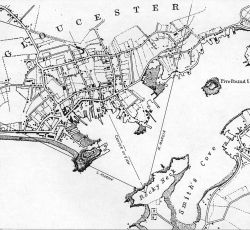
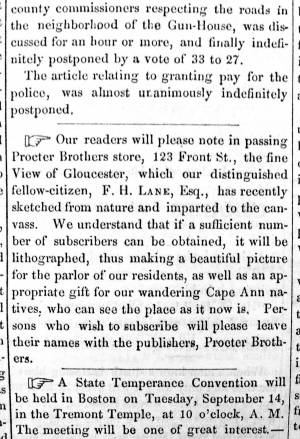
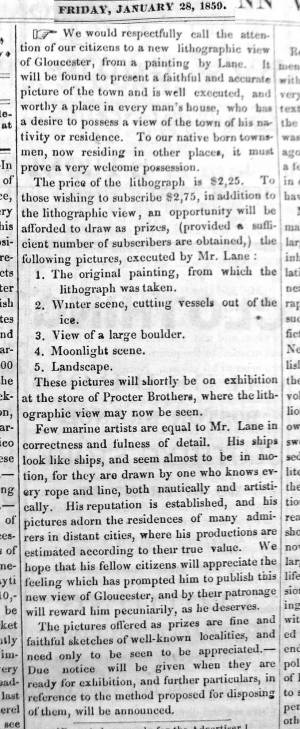
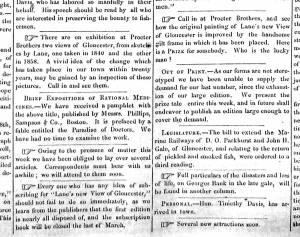


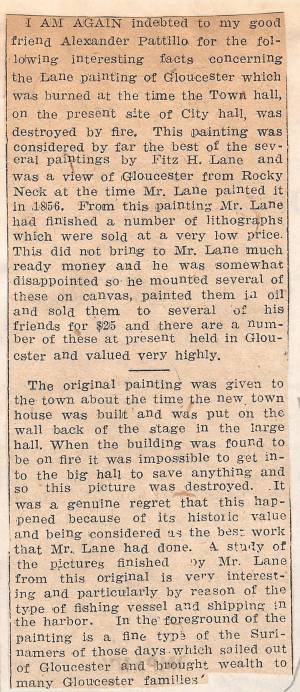


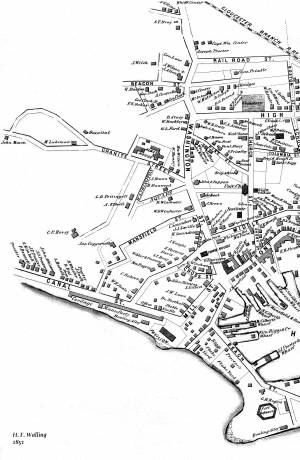
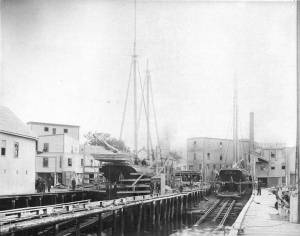
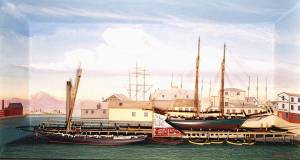
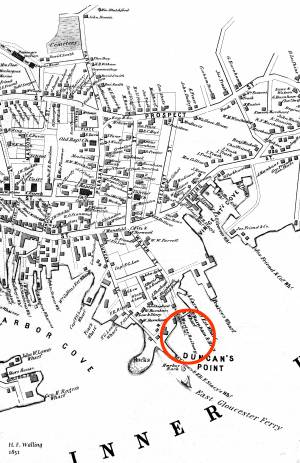
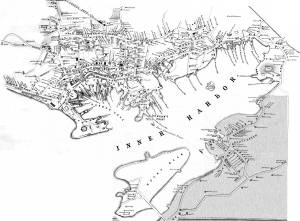



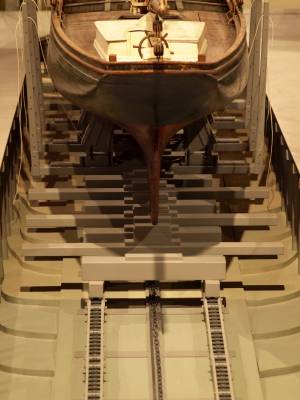
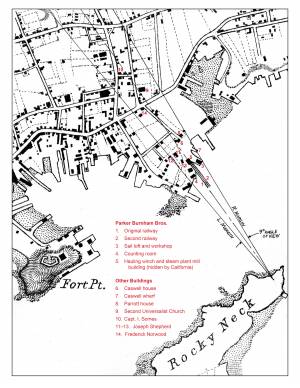
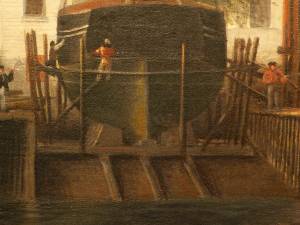
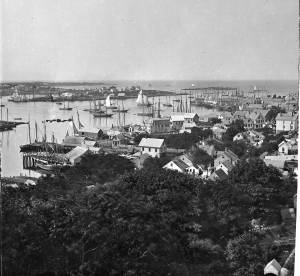

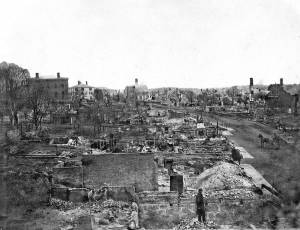
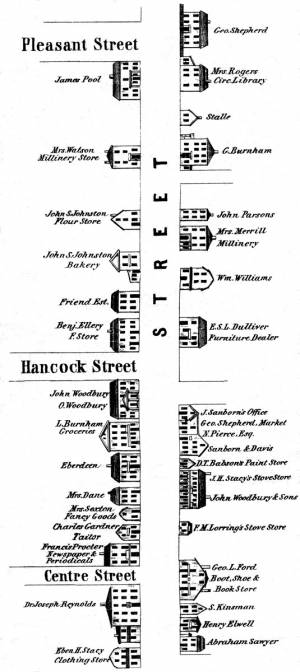
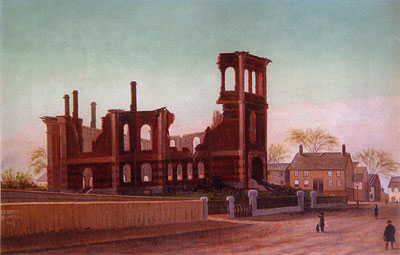

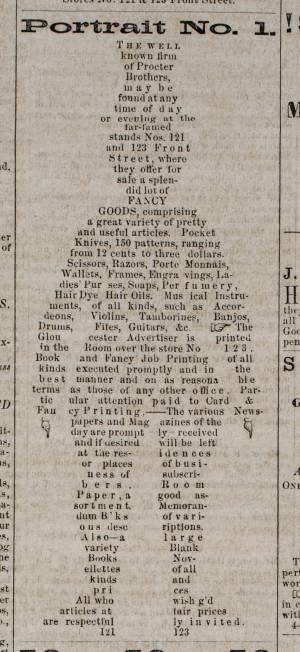
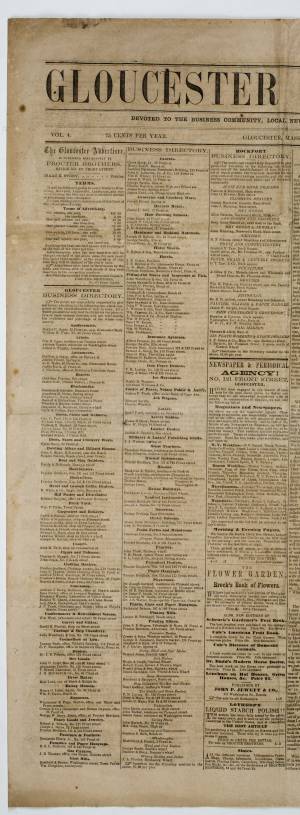

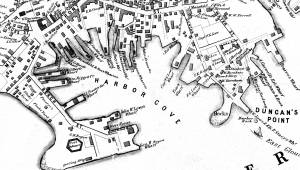



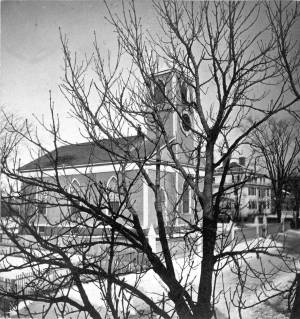
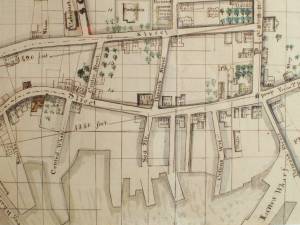

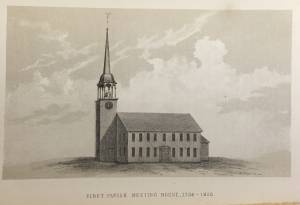
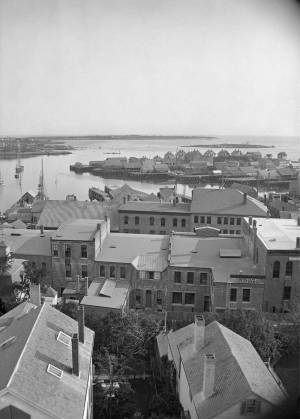

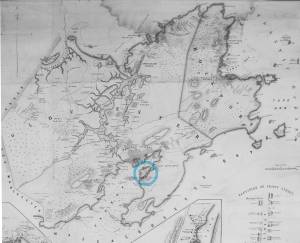
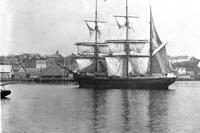

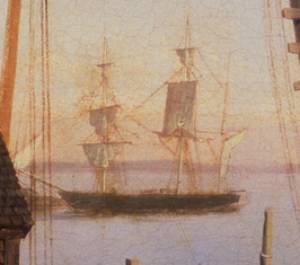


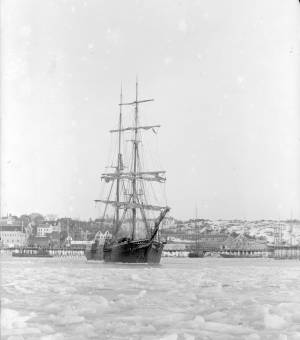

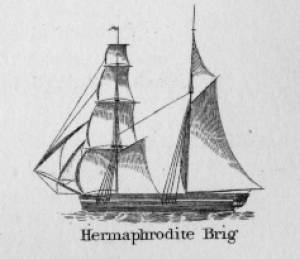

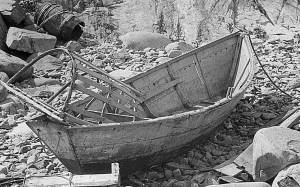


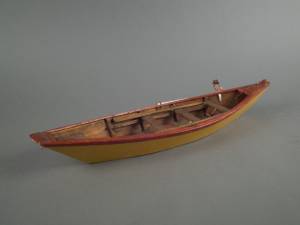


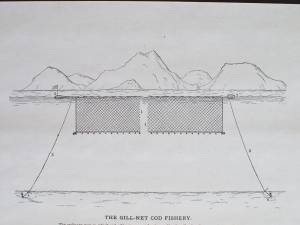

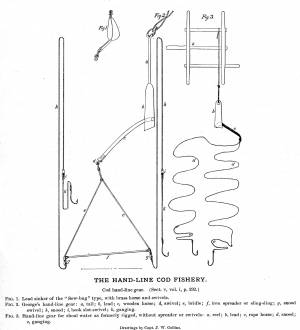
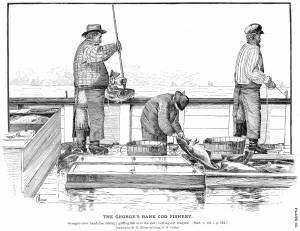
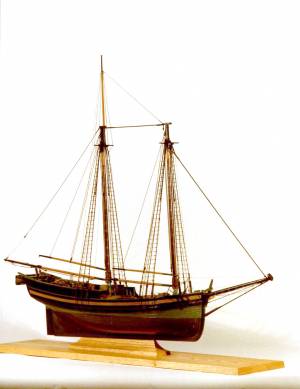
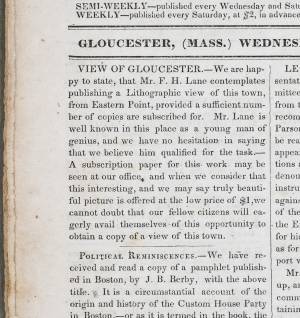
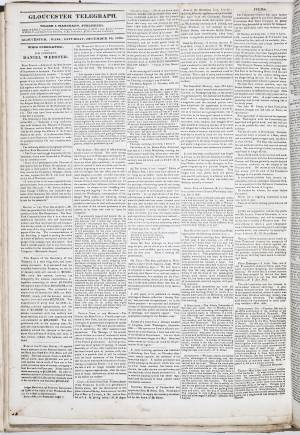
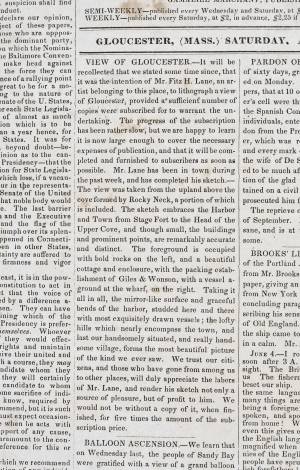
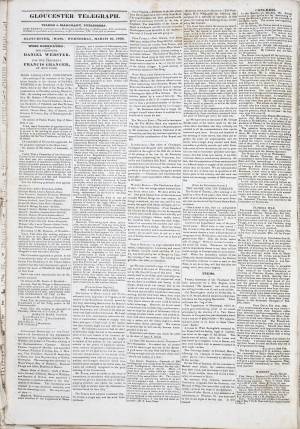


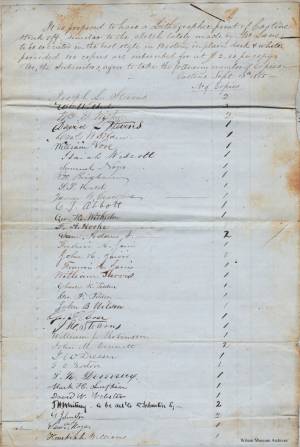

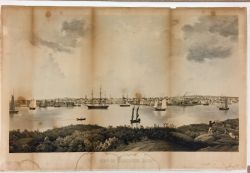
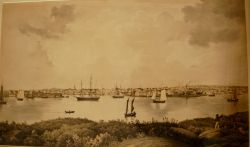

Commentary
This lithograph was published by Procter Brothers of Gloucester, and lithographed by L.H. Bradford & Co. It is known that Lane produced a painting from which the print was made, but unclear if he actually transferred the image to the stone.
Commentary and a Visual Guide
The third of Lane’s Gloucester lithographs is dimensionally the largest, but with the smallest angle of view: 74 degrees. His viewpoint was almost the same as the 1846 versions – perhaps fifty feet or so to the south and west. Given the same distance from Harbor Cove, the reduced angle of view served to further emphasize Harbor Cove, particularly Fort Point and Duncan’s Point, which saw the greatest changes in the years following 1846.
Harbor Cove’s peripheral expansion was due to the growth of a revitalized fishing industry. Gloucester’s foreign trade, whose prosperity had required ever larger vessels, was hampered by its shallow harbor and the attendant problems of berthing large ships and barks at wharfside. This problem was solved by moving ships and berthing facilities to Boston, which by 1860 was largely accomplished. With railroad connections between Gloucester and Boston already in place, Gloucester’s merchants could commute to Boston to manage their foreign trade business, leaving their old wharves and offices to a rapidly reviving fishing industry.
The third Gloucester lithograph was printed by Lodowick H. Bradford & Co., bearing the credit line “F.H. Lane pinxit” (“F.H. Lane depicted”) – which certainly attributes the original drawing to Lane, but less certainly the drawing on stone. This uncertainty is borne out in other lithographs, some of which credit Lane’s work as “on stone by…” or “drawn by…”, or “F.H. Lane del” (“del” = “delineavit”, “he drew”).
In this print’s case, Lane was arguably not responsible for the drawing on stone; the vessels are too inaccurately and incompletely rendered by his standards. Given inaccuracies in hull forms and proportions, and the lack of detail in the rendering of spars, sails, and rigging, it is hard to accept their rendering by Lane. Lacking as well are his careful depictions of rocks and stone piers; only the leafy vegetation is equal to his in mastery. The drawing of buildings most closely approaches that in Lane’s 1846 view, but even that aspect, while competently executed, shows differences in the treatment of line work, shading, and fine detail.
At 54 years of age, Lane, whose health was never robust, may have decided that drawing on a block of limestone two feet by three feet, by two to three inches thick, was a heavier task than he cared to manage. It seems probable that he left that task to another artist in order to fill on time this obligation to his publisher, Procter Brothers, Gloucester.
The lithograph, to judge from accounts in “The Cape Ann Advertiser”, starting in 1858, was inspired by a painting which Lane had recently completed. While a work on canvas was regarded as the source, it seems likely that the original drawing would have been used for making the image on stone, and the painting used as a guide for coloring many (but not all) of the lithographs. No evidence has been found yet that the lithographs were colored by Lane.
Vessel Activity
The numbers and types of vessels in this image are significantly greater than those of its preceding versions. The only sloop (1) is of significant size, though partially obscured by the left margin. The absence of a spring stay and a main topmast stay are the only clues to its single-masted rig. This vessel was probably used in the coastal packet trade.
Schooners (2) predominate. There is little doubt that nearly all are employed in the fisheries and are mostly of the “sharpshooter” and “clipper” models – built for speed to meet new fishing problems and promising new markets. Increasing efforts by Canada to impose greater control over its offshore fishing grounds forced American fishermen to build faster schooners to evade patrol vessels. At the same time, improved rail transportation to large inland markets led to strong demand for fresh fish. This necessitated making quicker homeward passages and the use of ice to keep the catch fresh.
Three half (hermaphrodite) brigs (3) are visible – reminders of the coastal trade, particularly the longer trips between Gloucester and Canada, or the southern ports as far as the West Indies. Their fore squaresails made them more suitable for coastal sailing routes farther offshore.
Two men in a wherry (4) are overhauling a previously set gill net. Anchored at both ends and hanging vertically in the water, the net was set in places where migrating schools of fish (such as herring) were likely to pass. The man in the wherry’s bow is starting to overhaul the net at one end, working his way to the other, removing fish caught by their gill covers in the mesh.
The lone bark (5) could be a last vestige of the Surinam trade, but is just as likely a “salt bark” in port with a cargo of “Tortugas salt” (West Indies sea salt) for processing dried salt fish. Later in this century, the salt trade expanded to importing Cadiz sea salt from Spain, and finally Trapani sea salt – highly regarded for its mildness – from the west coast of Sicily.
The small single-masted boat with one sail (6), i.e. “cat rigged”, is possibly a water boat. These craft brought fresh water to outbound vessels, their simple rigs facilitating the process of “coming alongside” to pump fresh water into the outbound vessel’s water tanks.
A yawl boat (7) with a two-masted spritsail rig is having its sails gathered to the masts in preparation to land. The spritsail resembles the gaff-headed sail, but uses a “sprit pole” to spread the sail’s peak (upper corner). The hasty furling shown here leaves the sprit pole in place, but gathers the sail to the mast.
A small steam-powered harbor ferry (8) traverses the harbor with commuters from East Gloucester. Ferry service has been indicated on harbor maps from 1850 and 1856, the earlier showing a sloop on the route. The 1856 map shows the route from a Wonson-owned pier in East Gloucester to the wharf of Low and Stacy at Duncan’s Point.
Key to vessels and buildings, left side
Key to vessels and buildings, right side
Fort Point
The entrance to Harbor Cove at its southwest side was guarded (literally so, on occasions) by Fort Point. Between the War of 1812 and the Civil War, Fort Defiance (as then called) was allowed to deteriorate – a process helped along by citizens partaking of its bricks and stone work to build foundations for new houses. Otherwise unused, save for a building used as a bowling alley, the land lay undeveloped until 1847, when George H. Rogers purchased parcels around the shoreline for wharves and buildings. In the decade that followed, his wharves covered the northeast and south shorelines, amounting to nearly one fourth of the frontage inside Harbor Cove. Residential housing soon followed, completely obliterating any trace of Fort Defiance’s remains when viewed from the south or east.
At the time Lane sketched this view, Sidney Mason has already built the Pavilion Hotel (A), ushering in luxurious hotel accommodations for wealthy tourists. In the distance, the Hovey mansion (B) atop Babson Hill dominated the highlands between central Gloucester and the Annisquam River.
The wharves and buildings (D,E,F) of George H. Rogers hide most of the visible Fort Point shoreline, the oldest part being the office/warehouse (E) which dates to 1848. The wharves themselves are more extensive and have many more buildings than in 1851, when the first section was in use. The schooners tied up at their north side (their masts visible over the roofs) are most likely fishing vessels, indicating that part of this wharf had already gone from receiving foreign trade goods to handling fish. The hidden adjacent wharf of John H. Lowe was soon to be taken over by Pettingill and Cunningham and evolve into the major fishing firm of Cunningham and Thompson.
In this view we also see the first residential buildings (C) to occupy land surrounding (and hiding) Fort Defiance’s remains. The Civil War would put a halt to this development as the fort was reactivated for the last time. The end of that conflict saw the resumption of new housing as immigrants flocked to Cape Ann to seek employment in a rapidly reviving fishing industry.
Beyond the north end of Harbor Cove, and situated prominently at the corner of Front and Washington Streets, was the Gloucester House (G), a large brick hip-roofed hotel which catered to a growing number of summer visitors and touring lecturers. With this establishment and the addition of the Pavilion Hotel, Gloucester took a major step toward the encouraging of tourism and the accommodation of summer visitors.
The angle of view in this lithograph leaves the west side of Harbor Cove hidden from view. The first identifiable wharves in sight are Charles Boynton’s (formerly G. Smith’s) Wharf (H) and Central Wharf (I), to the left of the Universalist Church (J). The schooners alongside them are indicative of a waterfront in rapid change from foreign trade to a reviving fishing industry.
Harbor Cove
While Lane’s 1859 lithograph of Gloucester Harbor was to a larger scale than his 1846 version, the detailing of wharves and their buildings is less clearly and precisely drawn. Lost are finer details and perspective, particularly where wharves overlap and the berthing slips can no longer be seen. This problem has prevented the identification of several wharves. This is unfortunate as Gloucester’s downtown area, particularly along the waterfront, was growing in response to the resurgent fishing industry. Following the fire of 1864, a new street between Front Street and the waterfront was laid out and named Rogers Street, sparking even further development.
Barely visible is Central Wharf (I), to the left of the Universalist Church (J). George Steele’s Wharf (K), formerly George H. Rogers’ Wharf is the next identifiable pier. To the right of the Collins School (L) and the Congregational Church (M) are the two wharves of John Somes (N). Back from the harbor is the Unitarian Church (O) and the house of Dr. Herman E. Davidson (P), who was Lane’s physician.
At the north corner of Harbor Cove is Collins Wharf (Q), site of Lane’s only known (to date) depiction of shipbuilding in Gloucester Harbor (Inv. 58). There, the shoreline turns eastward onto Duncan’s Point and more new harbor development. Dolliver’s Wharf and its hip-roof building (R) was previously owned by Frederick G. Low. Directly below the new Baptist Church (S) is the wharf and sail loft of Robert Fears (T), which is separated by a narrow slip from an enlarged wharf owned by Low. Next is a basin bounded by Parkhurst’s Wharf (U) which was built out over Duncan’s Point Rocks.
Duncan’s Point and Beyond
On the hilltop overlooking the bustle of Duncan’s Point is a stone house with seven gables (V) which was built and inhabited by one F. H. Lane. Below it and adjacent to Parkhurst’s marine railway is Burnham’s marine railway (W), the first such facility built in Gloucester, in 1849, followed by Parkhurst’s railway in 1854. Beyond is Pearce’s Wharf (X), marking the east side of the entrance to Vincent’s Cove (Y). Back from the Gloucester waterfront and on rising ground later to be known as Portuguese Hill is Gloucester’s Methodist Church (Z).
–Erik Ronnberg
[+] See More